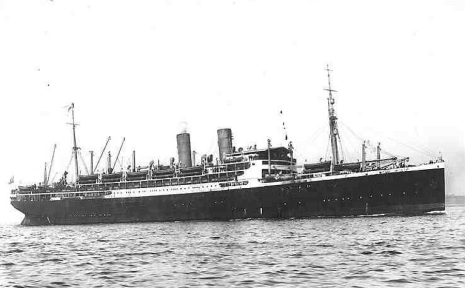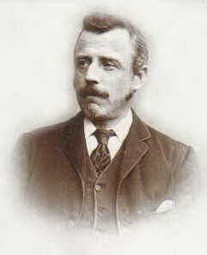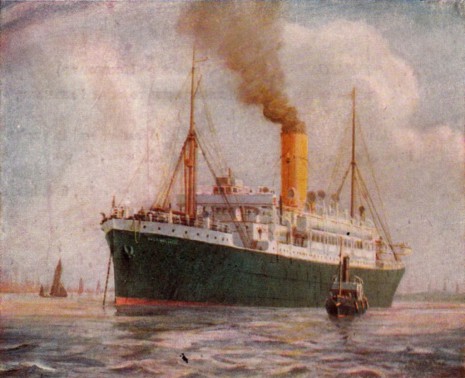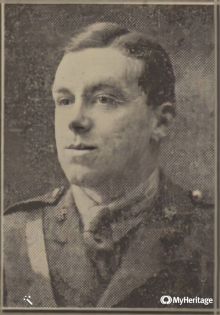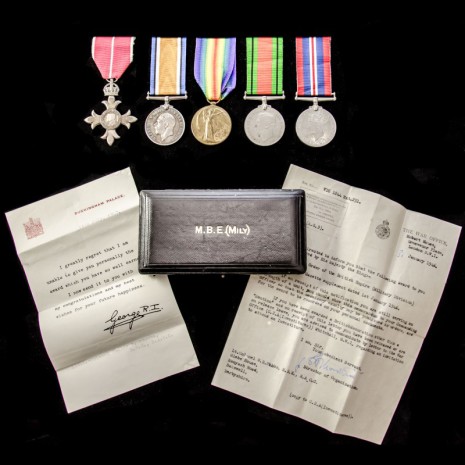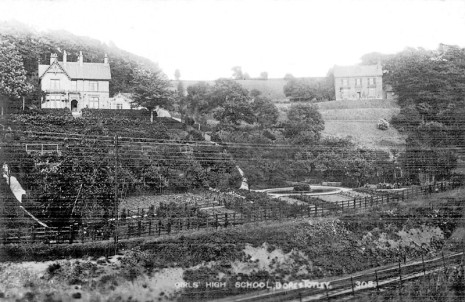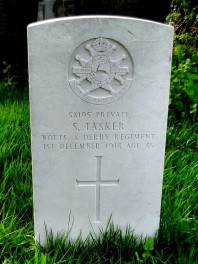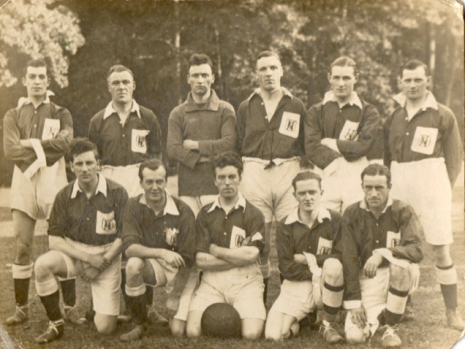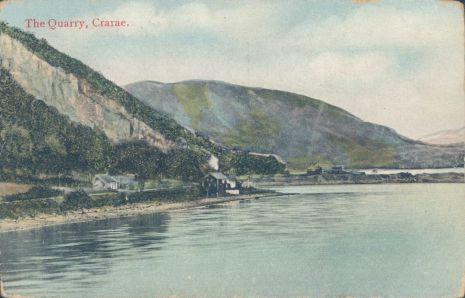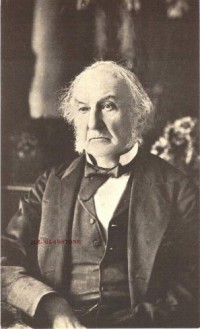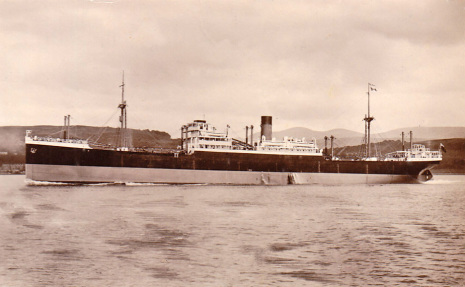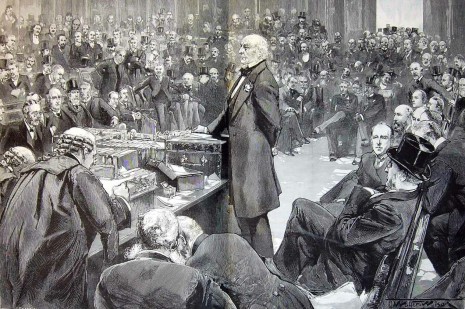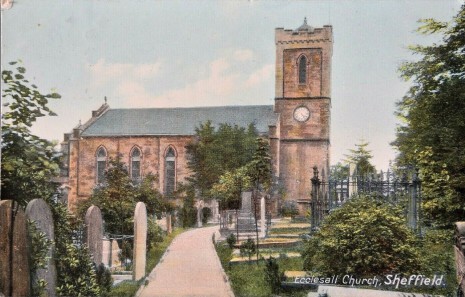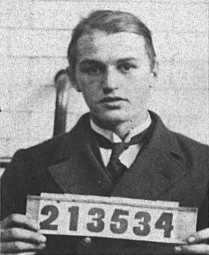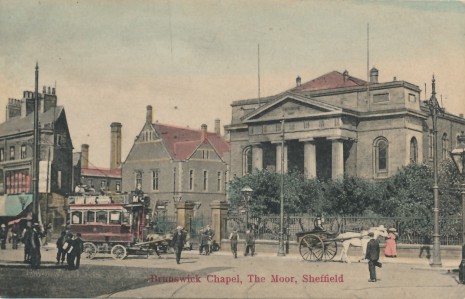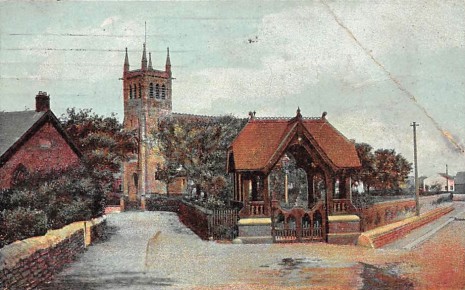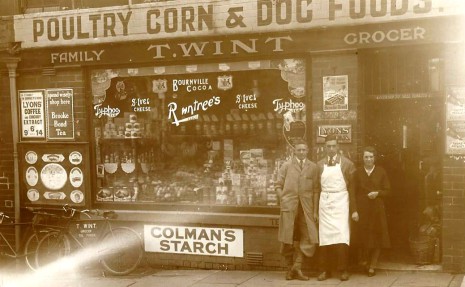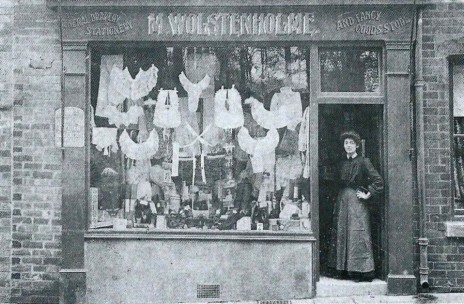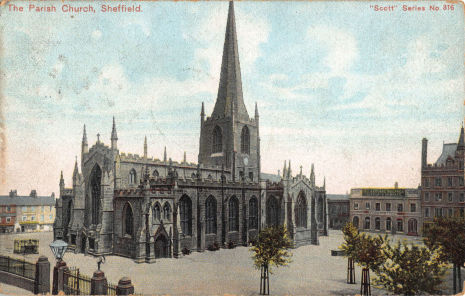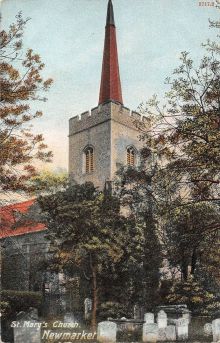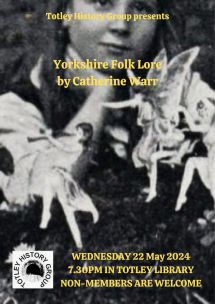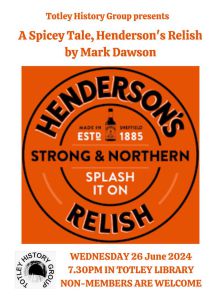WW1 Roll of Honour - The Survivors S-Z
Please see War Memorials and Rolls of Honour for the names of local WW1 soldiers and links to other soldier's stories.
Francis James Seed
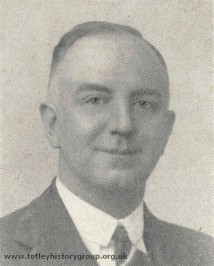 Reproduced by kind permission of NatWest Group © 2022. Not to be downloaded or copied except for private study.
Reproduced by kind permission of NatWest Group © 2022. Not to be downloaded or copied except for private study.
Frank Seed was born in Kettering, Northamptonshire in 1892. His father was Thomas Alexander Seed who was born in Keighley, Yorkshire in 1847, the second of eight children of John Seed, a grocer, and his wife Hannah Hird who had married on 14 August 1843 at the Parish Church, Bingley. Frank's mother was Emily Simonson who was born in Sheffield on 17 February 1850, the second of seven children of Christopher Simonson, a draper, and his wife Elizabeth Unwin who had married at Ecclesfield on 16 June 1846.
As a young man Alexander Seed had helped his father John run a grocers shop in Keighley but by 1871, when the family had moved to Sheffield, Alexander had become a student of theology. Whilst still in training he was sent to the Wesleyan Methodist Church in Leighton Buzzard, Bedfordshire and evidently preached to a large and appreciative congregation. The following year Alexander was preaching in Barrow-in-Furness, Lancashire.
He was ordained at the Norfolk Street Wesleyan Chapel, Sheffield on 4 August 1875 and a week later he married Emily at Park Wesleyan Chapel, Sheffield. Alexander was sent to work in Kilsyth, Glasgow, Lanarkshire. Two children were born there, Emily Sarah Elizabeth in 1876 and John Simonson in 1878 but John died later the same year. It was the policy of the Wesleyan Conference to appoint its ministers to stations (posts) annually and to move them to a different circuit (area group) at least every three years, but more frequently if it so chose. Alexander had three further stations before the next census: Snaith, West Riding (1878), Liskeard, Cornwall (1879) Kirkby Stephen and Appelby, Westmorland (1880). Two more children were born in Kirkby Stephen, Lucy Mary in 1881 and William Arthur in 1883.
The next move in July 1883 was to Alston, Cumberland where William Arthur died later that year and a daughter, Florence Hannah, was born in 1885. In July 1886 the family moved again to Melbourne, Derbyshire which was part of the Castle Donnington circuit. Thomas Alexander junior, known as Alec, was born there in 1887. In August 1889 Alexander was moved to the Kettering circuit where he initially held the station at Bridge Road Chapel, Gainsborough but later moved into Kettering itself where the Seed family were living at 66 Rockingham Road in the 1891 Census. Daughter Emily was not with them as she was attending Trinity House School in Southport, Lancashire. The school house was attached to Trinity Wesleyan Chapel, described by John Ruskin as "the most beautiful church in Methodism."
Frank was born in Kettering on 13 August 1892 and then they were off again to Chertsey, Surrey (August 1893), Liverpool (July 1895) and Tunbridge Wells (August 1896). Alexander was selected for a station at Peterhead, Aberdeenshire in July 1898 but appears to have declined that in favour of a move back to Gainsborough. In the 1901 Census Alexander, Emily and three of the children, Lucy, Florence and Frank were at 134 Bridge Street, Gainsborough. Lucy had become a music teacher. Daughter Emily was a milliner lodging with her employer in Mexborough. Alec was a pupil at Kingswood School in Charlcombe, Bath, Somerset.
In July 1904 Alexander was at first offered a station at Macclesfield, Cheshire but instead asked for permission to 'sit down' (no longer travel) and was given permission to remain in Sheffield's Brunswick Circuit as a supernumerary. He was aged 57 and it was effectively semi-retirement for him. Supernumaries were still expected to contribute to the work of the Church, often in an administrative capacity. Alexander was the translator of several books including Felix Buvet's "A Pioneer of Social Christianity: Count Zinzendorf" (1896) and M. Edmond Scherer's "What is Catholicism?" (1900) but now he had the time to write his own books which included "Brief Biographies of John and Mary Fletcher" (1906) and "Norfolk Street Wesleyan Chapel, Sheffield" (1907). The latter work was greatly praised by the Sheffield Daily Telegraph for the author's powers of investigation and research and his determination to verify every word he wrote.
In the census of 2 April 1911, Alexander, wife Emily and children Florence, Alec and Frank were living at Moorland View, 3 Chatsworth Road. Florence was an elementary school teacher with Sheffield Corporation, Alec was a clerk in a steel works and Frank an assistant librarian in the University of Sheffield. Daughter Emily had married Samuel Waterfall in 1908. Samuel worked for Midland Railway as a porter and later as a ticket examiner. Their son James Alexander had been born a month before the census which showed them living at 142 Rushdale Road, Meersbrook. Lucy had married George Rollett, a house painter and property repairer, in 1909 and they too had a young son, Frank, born 9 months before the census.
On 7 April 1913 Frank's mother Emily died at the age of 63. She was buried at Dore Christ Church two days later after a service at Totley Rise Methodist Church. Alexander remarried less than a year later to Mary Manners in Bishop Auckland, Durham. Although granted a further year as a supernumerary in Sheffield he had chosen instead to accept a station at Pateley Bridge, West Riding. Alexander and Mary lived at Summerbridge near Harrogate. Later that year daughter Lucy also got married. Her husband was Frank Fidler, a commercial traveller, and the marriage took place at St. John the Baptist, Abbeydale on 5 September 1914.
On 11 December 1915 Frank enlisted in the 3rd Battalion, York and Lancaster Regiment. His service record has survived and shows that he had become a bank clerk in civilian life. He was placed on Reserve and not mobilized until 9 February 1916. He was posted to Sunderland for training the following day and promoted to Lance Corporal on 9 August. However, he failed to complete his training programme, spending two months in hospital in Sunderland with a debilitating condition which prevented him from strenuous walking. He was transferred to light duties for several months but after being recalled to training he failed to complete the first route march. Frank was eventually discharged from service on 14 December 1918 under King's Regulation Paragraph 39 (xxva) "Surplus to military requirements (not having suffered impairment since entry into the service)". He gave his intended address on discharge as Westfield, 17 Edward Road, Gainsborough, Lincolnshire. Frank resumed his career with the bank workimg in the local Gainsborough branch.
Alec Seed married Beatrice Marguerite Pogson on 21 August 1918 at St. Peter, Abbeydale. Marguerite was the fourth of five children of Robert Henry Pogson, an employee of Sheffield Banking Company, and his wife Florence Henrietta Charlotte Mallender who had married at St Mary, Worksop on 21 October 1879. Marguerite was a professor of music and Licentiate of the Royal Academy of Music. They had twin daughters, Helen and Barbara, on 9 May 1923. Alec became a works manager and later a labour and publicity manager at Samuel Osborn & Co. steelworks. However, he was better known for his contribution to amateur dramatics in Sheffield being an actor, playwright, theatre administrator and theatre correspondent of The Era. He was at times the Chairman of the Sheffield Repertory Theatre and of the Croft House Settlement Operatic Society.
Rev. Thomas Alexander Seed died on 22 July 1926 at Cotherstone, near Barnard Castle, North Riding. He was aged 79. By then the Sheffield Banking Company had become absorbed into the National Provincial Bank and Frank was working at the same George Street branch as Robert Pogson. In 1939 Frank was living with a housekeeper at 25 Conduit Road, Crookes and working as a cashier and authorised signatory at the High Street branch. He retired on 1 November 1952, aged 60. Frank died on 14 December 1965 at Lodge Moor Hospital and was buried at Abbey Lane Cemetery three days later. He was aged 73 and unmarried.
Herbert Edward Victor Sibley
Victor Sibley was born in Sheffield in 1895. His father was Edward Sibley who was born in Gloucester in 1867, the sixth of ten children of George Sibley, an engine driver, and his wife Esther White who had married at St. Mary de Lode, Gloucester on 28 April 1860. His mother was Ada Rose West who was born in Bath on 20 January 1867, the second of seven children of Fred West, a publican, and his wife Hannah Cottle who had married at Walcot St Swithin, Somerset on 12 February 1865.
Victor's parents married on 5 August 1890 at St Mark, Lyncombe in Somerset. Edward Sibley was a clerk living at 244 Lancing Road, Highfield but when he came to Sheffield is not known. In the census on 5 April 1891, Edward and Ada were living at 40 Hobart Street, Highfield. He was in the early stages of a career in the City Accountant's Department where he would work for 37 years. A first child, Vera Hilda West, was born on 2 July that year in Bath, where Ada's widowed mother was a nurse. A son Harold Vernon was born in Sheffield on 7 May 1893 and Victor followed on 30 January 1895.
The Sibley Family must have moved to our area in spring 1897 because Vera, Vernon and Victor were admitted to Totley Church School on separate dates between May and September. No address is given for them other than Totley village. On 14 September that year another daughter Frederica Ada Victoria was born in Totley. School records show that the family left Totley in March 1900 and in the census of 30 March 1901 they were living at 266 Sharrow Vale Road, Sheffield. Edward was shown to be a district rate collector. A third daughter Violet Cecily May was born there on 4 May 1901.
The Sheffield Corporation Act 1900 formally consolidated townships like Attercliffe-cum-Darnall and Brightside Bierlow into Sheffield and extended the City boundaries to include parts of the adjacent parishes of Ecclesfield, Bradfield, Tinsley, Catcliffe, Handsworth, Norton and the Liberty of Beauchief. In December 1901 it was announced that Edward was one of four officials appointed to collect the rate for these new areas.
We think that the Sibley family returned to our area around 1903. The older children had attended schools at Pomona Street and Hunter's Bar and there is an entry on Freda's school record saying that the family "left town" on 31 March that year. A sixth and final child, Vincent Gordon, was born in Totley on 27 May 1905. Five of them - Vernon was the exception - were baptised together on 16 March 1910 at Dore Christ Church. They ranged in ages between 4 and 18. The parish register shows that the Sibleys were living at Alma Villas, (44-46) Victoria Road, Totley Rise and Edward was an assistant overseer of the poor. The census taken in the following April confirmed these details. Vera was an elementary school teacher with Derbyshire Education Committee. Victor and Freda were at grammar school.
Victor emigrated to Australia aboard the Tyser Line Indrapura which left Tilbury on 14 October 1913 bound for Melbourne. He was aged 17 and intended to work as a farm labourer. Soon afterward his arrival, however, war broke out and Victor enlisted at Melbourne on 19 August 1915 becoming Private number 4318 in the 13/5th Regiment of the Australian Imperial Force. He gave as his next of kin his father who's address was 48 Thirwell Road, Heeley thus indicating that the family had left our area yet again. They would stay at this location until the end of the war.
Victor was posted to join the British Expeditionary Force aboard HMAT Demosthenes which sailed from Melbourne on 29 December 1915. He served firstly in Egypt and then in France disembarking at Marseilles on 4 April 1916. On 27 September 1917 he was designated an Artificer indicating that he had a skilled mechanical or technical ability, in his case probably to do with motor vehicle maintenance as he was later transferred to the 6th Australian Motor Transport Company. He left France on 8 May 1919 and after arriving in England was sent to Sutton Veny, near Warminster in Wiltshire. Spanish influenza was particularly virulent at the time and no fewer than 142 Australian soldiers are buried in Sutton Veny churchyard. Victor survived the epidemic and was demobolised on 17 May 1919 in London. He was later awarded the 1914/15 Star, British War Medal and Victory Medal.
He did not immediately return to Australia but instead went to his parents home in Heeley. His father, according to the 1919 White's Directory, was the assistant overseer for Sheffield and Ecclesall Union. His sister Freda had become a teacher in Sheffield having studied at Sheffield Pupil Teaching College between August 1914 to July 1916.
On 3 January 1921 Victor married Jessie Prosser at St. John's Church, Abbeydale. Jessie was born in Sheffield in 1896, the sixth of eight children of Charles Albert Prosser, a silversmith, and his wife Mary Elizabeth Wright who had married at St. Mathias, Sheffield on 1 October 1882. The Prosser Family lived at Woodbine Cottage, Victoria Road and would have been close neighbours of the Sibleys. Jessie had been a classmate of Freda Sibley at Dronfield Grammar School. Sadly their son David Harry Prosser had been killed in the war and is commemorated on the war memorial at St. John's, Abbeydale. We don't know where Victor and Jessie lived but Edward and Ada had had moved to Old Norton by 9 May 1921 when their daughter Cicely married George Benjamin Smith at St. James Church. On a sad note Vernon Sibley died on 22 October 1921 at the Royal Infirmary, following an operation. He was aged 28 and unmarried.
Early in 1922 there was another Sibley family wedding when Freda married Frederick Arthur Bennett at Norton St. James on 14 January. The same year, Victor returned to Melbourne accompanied by Jessie aboard the Orient Line Ormuz which sailed from London on 11 November 1922. He gave his occupation as market gardener. Victor's younger brother Vincent also emigrated to Australia travelling alone on the Commonwealth Ship Esperance Bay which sailed from London on 28 August 1923 arriving in Melbourne on 5 October.
Our knowledge of what became of the brothers in Australia is very limited. Vincent become a welding supervisor in Wilmot, Tasmania. He married Helen Marion Sinclair and paid a visit to England in 1953 arriving on 3 August aboard the Orient Line Orsova and returning on 23 September on its sister ship Orcades. Whilst in England Vincent stayed with his eldest sister Vera in Frampton, Dorset. She had continued her career as a school teacher after her marriage to William Graves in Axminster, Devon in 1933. Vincent later lived in north east Victoria and died in Bright, a holiday centre for the Alpine and Buffalo National Parks, in 1993. He was aged 83. Victor and Jessie lived in the Gippsland Division (County), east of Melbourne until around 1948 when the moved to Wannon Division, in the south west of Victoria. Jessie died in 1973 and Victor died at Heywood, Victoria in 1977.
James Singleton
James Singleton was born in Sheffield and baptised at St. Silas, Broomhall on 30 April 1884. His father was Leonard Singleton, who was born in Sheffield on 30 January 1855, the youngest of five children of William Henry Singleton, a shoemaker, and his wife Mary Hill who had married in 1843. James's mother was Mary Cousins who was born in Sheffield in 1858, the only child of Joseph Cousins, a porter, and his wife Amelia Foulds who had married at Christ Church, Pitsmoor on 22 October 1854. Mary's father had died the year after she was born and she had been brought up by her grandparents until her mother remarried to William Atkinson.
James's parents were married on 31 October 1875 at St. John's, Park, Sheffield. Leonard Singleton was a (mother of) pearl grinder working in the cutlery trade. Their first child Frederick was born the following year and baptised on 25 June at St. Silas, Broomhall, which had been built only in 1867. Leonard and Mary were living at Wellington Street in the city but when Mary Ann, their second child, was baptised on 29 August 1878 they had moved to Aberdeen Street, Broomhall living at Court 3, House 1, or number 53 as it was later known.
A further six girls and seven boys were born there in the course of the next 23 years: Leonard (1879), Ellen (1882), Florence (1883), James (1884), Amelia (1885), Henry (1887), William (1889), Elizabeth (1891), Arthur (1893), Charles (1895), Grace (1897), Harold (1899) and finally Elsie (1901). Only Leonard and William died in infancy. Life was a struggle and the children did not get much schooling. Frederick, the eldest, was working in the pearl trade by the age of nine. Aberdeen Street ran from Broomhall Street to Upper Hanover Street and was demolished in building the inner ring road in the mid 1960s.
James became a pearl grinder like his father and several of his brothers. On 30 June 1906, he married Violetty Elliott at Sheffield Register Office. She was born in Sheffield on 24 April 1885, the sixth of nine children of George Elliott, a spring knife cutler, and his wife Mary Cooper who married at the Cathedral Church of St. Peter and St. Paul on Christmas Day 1871. The spelling of her forename was a problem for officialdom throughout her life. Her birth was registered as Violetty but her baptism at the Cathedral Church on 15 March 1885 was recorded as Violetta. The name can be traced back to Violetta Truelove, born in Sheffield in 1803, who married her grandfather James Elliott in 1830 but it probably goes back even earlier than that. A son, Leslie Stuart, was born on 2 August 1906. We don't know where the family were living until 1911 when the census shows that they were at 53 (Queen) Victoria Road, Totley Rise. They would remain at this address until after the war.
James attested on 21 June 1916 and was mobilized on 13 April the following year. His eyesight was slightly defective which barred him from certain military duties but not from service aboard. James became Pte. M/314426 and was sent for training as a heavy lorry driver to the Army Service Corps MT (Motor Transport) Training Depot at Isleworth, Middlesex. He was sent overseas embarking at Portsmouth on July 1917 and served at Basra and in the Kashmir during which he had short spells in hospital for sandfly fever, a viral infection with influenza-like symptoms. He returned from Basra on 30 August 1918 and spent the rest of his service in England, being discharged on 24 April 1919.
We have not researched into what James's siblings did during the war since they did not live in our area but we do know that his brother Henry served in the army and was later engaged by the RAF. Henry had married Ada James at Heeley Parish Church on 9 August 1909 and had a son, Ernest, the following year. After the war Henry had returned to his occupation as a pearl cutter and was living at 31 Alexander Road, Heeley. However, that all changed on 11 April 1922 when the family embarked at London on the steamship Moreton Bay, and disembarked at Freemantle, Western Australia. They had travelled on the Commonwealth Government's New Settlers Scheme which was focussed on attracting ex-soldiers and their families to emigrate to Australia.
Whether encouraged by his brother or not, we do not know, but James and his family followed the same route the following year, sailing from London on 21 July 1923 aboard the Aberdeen White Star Line's SS Demosthenes and disembarking at Freemantle. As we do not have access to Australian records our information about what happened to the two Singleton brothers and to their families is limited. We do know that they both became farmers in the same area and that their sons shared the same farm for a while at least.
In 1936 James, Violetty and Leslie were at Lees Hall Farm, Busselton, Western Australia. Busselton is on the coast, 140 miles southwest of Perth and is now one of Western Australia's most popular holiday resorts. Leslie married Joan Angela Mary Edgecombe on 20 July 1951. Joan was born in East Preston, Sussex in 1920 and emigrated with her family aboard the SS Hobsons Bay in 1926. By 1954, Joan and Leslie had two sons, James George and Stuart Leslie, and were at Merrilees Farm, Busselton. Violetty died on 11 June 1964, aged 79, and was buried at Busselton Cemetery, Yalyalup, Western Australia. James died on 6 July 1978 aged and was buried at the same cemetery.
Walter Rippon Stubbs
Walter Stubbs was born in Rotherham, Yorkshire in 1897. His father was George Stubbs who was born in 1865 in Framwellgate, Durham, the sixth of nine children of Thomas Stubbs, a colliery manager, and his wife Frances Clough who married in Sunderland on 5 June 1854. Walter's mother was Gertrude Rose who was born on 9 August 1863 in Doncaster, Yorkshire, the third of twelve children of John Horner Rose, a grocer, and his wife Maria Rippon who married at the Parish Church, Eckington, Derbyshire on 15 August 1860.
Walter was descended from Durham mining families. His grandfather, Thomas Stubbs, worked his way up to being a colliery overseer before relocating his family in the 1860s to become an underground steward at the Holmes Colliery at Brinsworth, Rotherham. By 1871 he had became the certificated manager of the colliery. His son George had become a colliery clerk by the time he was sixteen but in 1882 he changed occupation and became a clerk to the Rotherham County Court.
George Stubbs married Gertrude Rose at Doncaster Parish Church on 5 September 1888. Their first child, Leslie Norman, was born on 15 June 1889. In the 1891 Census the family were living at 26 Wellgate Mount. A daughter, Marjory, was born on 20 December 1893 when the family were living at Broom Villas, Moorgate Grove.They were still there when Walter was born on 19 February 1897. Whilst the two younger children were baptised a few weeks after their birth, for some reason Walter was not baptised until 5 November 1906 by which time the family had moved home again to Cloughville, Clough Road, Masborough. They were at Cloughville in 1911 when the census recorded that Leslie had become an engineer in a steel works. Walter was a scholar.
Soon afterwards, the Stubbs family must have moved to our area because White's Directory for 1912 lists George at Heatherleigh, 36 Devonshire Road. Walter joined the staff of Sheffield Savings Bank, Norfolk Street as a clerk. In 1915 he joined the Sheffield University Officers Training Corps and in the five months he spent with them he rose to the rank of Sergeant. Walter received a commission as temporary Second Lieutenant in the 19th Nottinghamshire and Derbyshire Regiment (the Sherwood Foresters) with effect from 8 December 1915 and was sent to France with the British Expeditionary Force on 25 July 1916. He was promoted to Lieutenant on 12 February 1917 and then to Captain on 7 April. On 20 August, however, he suffered eight shrapnel wounds. Although not life threatening, they were serious enough to warrant his repatriation to England on 6 October and presumably transfer to Reserve.
On 8 February 1921 Walter married Muriel Gummer at St. John the Baptist, Abbeydale. Muriel was born on 20 December 1896, the only daughter of William Guest Gummer, a brassfounder, and his wife Gertrude Hemingway who had married on 21 April 1889 at Horbury St. Peter and St. Leonard, near Wakefield. Muriel was a former member of the Totley Dots and Tots troupe of entertainers. Like the Stubbs family, the Gummers were from Rotherham but in 1921 they lived at Fern Bank, Brinkburn Vale Road. Muriel's brother Stanley Gummer had been killed in action at Passchendaele on 9 October 1917.
A first child, William Leslie Stubbs, was born at Fern Bank on 22 May 1892. However, when Walter claimed his war medals in November 1923, they were despatched to a house on Totley Brook that had been named Sherwood. The house stood close to the junction with King Ecgbert Road and has been replaced by a block of flats known as Sherwood Chase. A second son, Ian Patrick, was born at Sherwood on 18 December 1925.
Walter's father, George Stubbs, died on 17 November 1935 at his home of Arrandale, 32 Vernon Road, Totley Rise. He was aged 70. He had retired a few years earlier from his position as Chief Clerk at Rotherham County Court, having completed fifty years service on 7 January 1932. Keen on both football and cricket - hobbies he passed on to his sons - he was on the Sheffield United Committee and a former treasurer of Rotherham Cricket Club. The funeral was at Dore Christ Church on 20 November. Gertrude Stubbs never remarried and lived in the same house until her death in 1954, aged 90.
We do not know when Walter and Muriel left Totley Rise but in the 1939 Register they were living at 85 Crimicar Lane, Fulwood. Walter was the manager for a tools manufacturer. He was re-commissioned into the Sherwood Foresters as a Second Lieutenant on 16 January 1940 and was appointed temporary Lieutenant Colonel in the Royal Army Ordnance Corps on 30 November 1941. For his service in both wars, Walter was made a Member of the Military Division of the Order of the British Empire in the New Year's Honours List for January 1946. Walter died at Fulwood on 23 November 1962, aged 65. Muriel died eleven days later on 4 December, also aged 65.
Walter's M.B.E., its accompanying case and documentation, and his set of service medals came up for auction at Bonhams in 2014. It was sold for £288.
Bertie Shaw Sylvester
Bertie Sylvester was born in Millhouses, Sheffield in 1895. His father was Samuel Sylvester who was born in Sloothby, Lincolnshire on 24 March 1838, the sixth of seven children of Joseph Sylvester, a farmer, and his first wife Mary Bush who had married on 29 April 1823 at Gunby St. Peter, Lincolnshire. His mother was Kate Dorothy Shaw who was born on 24 May 1868 in Derby, the third of four children of William Fleetwood Shaw, a compositor, and his first wife Harriet Francis who had married in 1861 in Nottingham.
Samuel and Kate married on 20 June 1893 at Trinity Chapel, Highfield, Sheffield. It was Samuel's third marriage. He had two children from his marriage to Caroline Turner in 1839 and three from his second marriage to Elizabeth Ringrose in 1865. It was Kate's first marriage; she was thirty years his junior. Her mother had died when she was an infant and she was brought up by her grandparents Eli and Louisa Francis in Wolverhampton.
Samuel and Kate lived at Abbeydale View, 80 Millhouses Lane when their first child Bertie was born on 28 May 1895. A daughter, Doris Victoria, was born on 22 September 1897. Samuel was a wholesale and retail cigar and tobacco merchant with a business at 41 Surrey Street, Sheffield. In the census of 30 March 1901, living with them were Caroline, aged 38, a daughter from Samuel's first marriage and Archibald, aged 15, a son from his second marriage. Caroline married James William Corden, a Grimsby fish merchant, in 1903 probably at Abbeydale St. John's where the family were prominent members of the congregation.
By 1904, Samuel and Kate had moved to Dore where daughter Edna Irene was born on 17 December. Their fourth child Vera was born in Dore in 1907. In 1911 the family, which still included Archibald, were living at Llanover, a large house with more than am acre of gardens at the bottom of Twentywell Lane close to the original Dore High School run by Selina Shrubsole.
Bertie's war service record has not survived. We know that he became a Second Lieutenant in the 4th Battalion of the York and Lancaster Regiment before being seconded to the RAF in 1918 as an observer officer and promoted to Lieutenant. He was demobilised on 23 January 1919 and resigned his commission on 8 October the following year. He was awarded the Victory Medal and the British War Medal, suggesting that he did not serve overseas before 1916. During the war Bertie had married Annie Hides. Annie was born in Sheffield on 25 July 1897, the only daughter of Charles Hides, a butcher, and his wife Bertha Clark who married in Caistor, Lincolnshire in 1896.
Samuel Sylvester died on 1 October 1919 aged 81 and was buried at Dore Christ Church three days later. An obituary noted that Samuel had been the President of Dore and Totley Golf Club since its foundation and Bertie too became a keen golfer at the same club. It would appear that after his father's death Bertie took control of the family tobacconists business which for many years had acted as agents for Messrs Mitchell & Co., wholesale tobacconists of Glasgow. Llanover was put up for sale at auction and Bertie and Annie went to live at Froggatt with their young son Kenneth Richard Hugh who had been born in 1919. Sadly Kenneth was killed in action in 1940.
Annie and Bertie's marriage ended in July 1935 and they both remarried. Bertie married Bertha Wilhelmina Freiert at the Register Office, Bakewell. She had been born in London on 16 May 1904 and raised by her grandfather Paul Freiert, a plumber, and his wife Marie. In the 1939 Register, Bertie and Bertha were recorded as living at Gable Cottage, Stoke View, Bamford. Bertha died in 1979 aged 75. Bertie later lived at Flat 9, Mount Pleasant Road, Grindleford. He died on 10 October 1987 aged 92.
Charles Brinton Tasker, Saville Tasker and William Roper Tasker
George Herbert Tasker and his American-born wife Fanny moved to Totley Brook Road from Nether Edge some time between 1907 and 1909, living first at Eastbourne (number 36) and then, by 1911, next door at Westbourne (number 38).
George had been born in Sheffield in 1860; his father, Samuel, had been a wire worker. George was a toy merchant and dealer in smallware (narrow fabric items such as tapes, cords, braids etc) with premises in Orchard Place and Pinstone Street. Fanny, nee Roper, had been born to British parents in Trenton, New Jersey, in about 1856. George and Fanny had five children, all born in Sheffield: Willie Roper Tasker, who in 1991 was working as a traveller for his father’s firm; Saville, then working as an assistant to his father; Pauline; Charles Brinton Tasker, then a radiator fitter; and Harold, an engraver to a silversmith. In 1911, the household also included William’s wife, Lucy, and their son, recorded as John Roper Tasker, although his official name seems to have been Jack rather than John.
George Herbert Tasker died at the Royal Infirmary, Sheffield on 14 th February 1916, aged 56. While he had originally been with the firm of Tasker and Roper, toy and smallware dealers of Pinstone St, in 1910 he had started a business in Orchard Place, using his wife’s name to trade as F. Tasker and Company, toy merchant. After his death, his son (presumably William) managed the business, which until 19 July Fanny believed to be quite solvent. Sadly it was not, and on 12 August 1916, when she was still living at Westbourne, she filed for bankruptcy. Fanny died on 10 th December 1930, aged 75; her address at the time was at 46 Bowood Road in Sharrow Vale. George and Fanny were both buried in Dore churchyard.
William Tasker was born in 1882. In 1911, he was working as a traveller for a smallware dealer – presumably his father - but by 11 June 1917, when he was called up for service, he was a shell inspector. He was then 36 years 4 months old; 5ft. 6ins. tall, weighing 120 lb. He was then living at Vineleigh, 47 Cobnar Road, Woodseats, Sheffield with his wife Lucy, the widow of Charles Manwaring, whom he had married in February 1907, and their son Jack, born in December 1907.
He joined the Royal Regiment of Artillery (Royal Garrison Artillery) as a private (regimental number 167219), and was a bombardier (the equivalent of a corporal) when he was demobilised in March 1919. He was deemed on medical examination not to have any disability due to his military service: though he was said to require dentures, he was noted on call-up as having defective teeth which required attention. The 1939 Register shows that, not long before his death, aged 57, in 1939, he was again working as a commercial traveller, and living on Machon Bank, in Nether Edge. Lucy died in 1941 aged 70.
Saville Tasker was born in 1884 and educated at Montgomery College, Sharrow. In 1911, he was working as an assistant to his father. As an amateur footballer, he played for Sheffield Wednesday and Rotherham Town.
He served as a private (regimental number 58195) in the 11th Battalion Notts and Derby Regiment (the Sherwood Foresters). Saville died on 1 December 1918 at 134 Vincent Road, Sheffield. The significance of this address is not known: his father had died in February 1916, and his mother seems to have been living at 30, Briar Road, Nether Edge, at the time of Saville’s death. He died while on hospital furlough having served two and a half years in France and Italy, being twice badly wounded. Saville’s death certificate states that his death was reported by the Coroner for the City of Sheffield, rather than by a relative or friend: an inquest held on 3 December determined the cause of death as double pneumonia, and it is possible that this was caused by the Spanish flu which reached its peak in Sheffield in November 1918. Whoever provided information to the Coroner may not have known Saville well: his age at death is recorded as 32, whereas in fact he had been born in 1884, and was thus 35, as his headstone shows. He is buried in a Commonwealth War Grave in Dore churchyard and remembered on the memorial at Trinity United Reformed Church, Ecclesall.
Charles Tasker was born in 1891. In 1911, he was working as a radiator fitter. He signed up for military service on 13 January 1915, when he was aged 23 years 6 months. He was unmarried, and was still living with his parents at Westbourne. He was a heating engineer. He was assigned as a private to the West Riding Regiment (regimental number 15194), and seems to have been sent to France on 26 August 1915. Although apparently wounded on 19 September 1916, he was not demobilised until February 1919.
Charles was a talented footballer who, like his brother Saville, was on the books at Sheffield Wednesday. A photograph in the possession of his grand-daughter shows him in a football team – presumably that of the engineering firm, Newton Chambers, for which he worked. In 1934, Charles married Elizabeth Thorpe, whose older sister Evelyn had married Benjamin Biggin, the nephew of George, Rowland and Ellis Biggin, in 1927. Their son David Richard Brinton Tasker was born in 1937. The 1939 Register shows the family living at 961 Ecclesall Road; Charles was an electrical welder at an armament works. He died, aged 68, in 1960, and was buried in Dore churchyard, where his wife Elizabeth and son David were also buried, in 1987 and 2005 respectively.
Arthur Stanley Taylor
Arthur Stanley Taylor (known as Stanley) was born in Sheffield in 1886. His father was Samuel Arthur Taylor who was born in Sheffield in 1863, the second of four children of Joseph Taylor, a cabinet and showcase maker, and his wife Sarah Ann Moody who married on 8 March 1859 at St. Mary's, Bramall Lane. Stanley's mother was Rose Hannah Grayson who was born in 1861 in Hathersage, Derbyshire, the youngest of seven children of John Grayson, a blacksmith, and his wife Mary Brailsford who married at St. Michael and All Angels, Hathersage on 9 December 1845.
Stanley's parents were also married at Hathersage on 30 June 1884. Samuel Taylor was a cabinet maker working in his father's business, Taylor Brothers of 205 South Street. Sheffield. A son Frank Grayson Taylor was born in Sheffield the following year and then Stanley on 18 September 1886. On 10 December 1887 a receiving order was made against Stanley's grandfather and the business went into bankruptcy, the equipment and stock being sold at auction in January 1888.
Samuel moved his family to Bridlington Quay where Rose ran a lodging house at 3 Sea View, whilst Samuel continued as a journeyman cabinet maker, apparently working in both Sheffield and Bridlington. In the 1891 Census Samuel was recorded at South Street with his parents, sister Annie and brother Joseph whilst Rose was in Bridlington with Frank and Stanley. Sadly Frank died on 5 October 1892 aged 6. Another son, Lance Neville, was born in Bridlington in 1894.
The lodging house venture was not successful and a receiving order was made against Samuel on 16 September 1895. At his bankruptcy examination, Samuel said he had set up the business with no money capital but with furniture brought from Sheffield. He attributed his deficit of £27 1s. 2d. to "bad seasons". The family returned to Sheffield and by 1901 were living at 18 Gatefield Road, Nether Edge. They had moved to 23 Gatefield Road by 1911. Stanley had become and assistant manager with a firm of electricians and Lance was an analytical chemist for a steel manufacturer.
Stanley married Alice Amelia Fauvel on Christmas Eve 1913 at St. Oswald's, Bannerdale. Alice was born in New York City on 27 August 1886, the third of eight children of Owen Charles Fauvel, a ladies tailor, and his wife Lavinia Hannah Moore who had married at the British Embassy in Paris on 18 December 1880. Alice's younger brother, Lionel Georges Fauvel, was another of the soldiers whose name is remembered on the Roll of Honour at St. John's, Abbeydale.
Stanley and Alice had three children, the first of whom was Laurence, born on 5 October 1914 in Sheffield. The Sheffield Soldiers of the Great War website reports that Stanley joined the Royal Engineers and became a Corporal but it would appear that his service record no longer exists to confirm this.
Lance Taylor also joined the Royal Engineers as a Pioneer, attesting in Sheffield on 13 November 1915. He was mobilized on 22 January 1917 and served on the Home Front until 20 March that year before being sent to France with the British Expeditionary Force. Lance was injured by gas on more than one occasion in 1918 most notably on 30 June when, during the fitting of gas shells with pistol heads, one shell exploded causing "moderately severe" poisoning with phosgene gas. Lance survived the war and was demobilized on 22 January 1919. He later became the Chief Chemist with steelmakers and engineering tool manufacturers Samuel Osborn & Co. Ltd.
After the war, Stanley and Alice had two more children that we know about. Joyce Winifred Patricia was born in the spring of 1921 but she died at the age of six months and was buried at Dore Christ Church on 21 October when the family were living with the Fauvels at Brookside, Abbeydale Road South. A son, Lionel Jeffrey, was born on 21 May 1923. When the National Register was compiled on 29 September 1939 the Taylor family were living at 2 Edmund Avenue, Bradway. Stanley's occupation was a salesman buyer and Laurence was a wireless engineer. Stanley and Alice later moved to 192 Abbey lane where Stanley died on 16 January 1976 at the age of 89. Alice died in 1982 aged 94.
Norman Kenneth Thomson
Norman Thomson was born in Bradford, West Yorkshire in 1882. His father was Richard Thomson who born in Dalkeith, Midlothian in 1841, the second son of Robert Thomson, a corn miller, and his wife Jessie. His mother was Janet Stevenson who was born in Edinburgh in 1844, the eldest of three children of Peter Stevenson, a scientific instrument maker, and his wife Janet Martin.
Norman's parents were married at No. 56 Lothian Street, Edinburgh on 17 July 1866 by Janet's granduncle, Rev. Thomas Martin, Senior Minister of the North Free Church, Strathmiglo, Fife. At the time Richard was working in Glasgow as a draper and their first child, Janet, was born in that city in 1867. The following year, however, the family moved to Bradford, Yorkshire where Richard became firstly a stuff warehouseman and then a stuff merchant. The word stuff was used to mean a quality cloth that was made from wool or a wool mix. Richard worked for John Young, Messrs Woodhouse and Co., and afterwards for Messrs A. and S. Henry & Co. before becoming a partner in the firm of Gillies, Garnet & Co. of Hall Ings, Bradford.
Three children, Robert (1868), Mary Jessie (1869-70) and Peter (1871) were born before the 1871 Census which reported the Stevenson family living at 23 Southey Place. They were prosperous enough to have a live-in domestic servant. Six more children followed in the next decade: Margaret (1873), Alexander (1874), May (1877), Richard (1877), Florence (1878) and Willie (1880-80). In the 1881 Census the family were living at 27 Merton Road, Horton. Norman was born on 29 March 1882 and then Alice, the youngest child in 1884.
On 25 September 1886 Norman's grandfather, Peter Thomson, was killed at Crarae Quarry, Loch Fyneside in quite dreadful circumstances. Evidently it was a popular spectacle to take a boat excursion on the Loch to witness the explosion of rock from blasting at the quarry. After the explosion about three hundred of the spectators left the boat to inspect the quarry but on this occasion many of them were overcome by "choke-damp", fumes of carbonic acid gas and sulphurous oxide, remaining from the explosion of the gunpowder. Seven people, including Peter, were killed. A popular man, Peter had become internationally well-respected and prosperous through designing and manufacturing meteorological instruments to measure rainfall, temperature and air pressure and gone on to hold a licence to supply the Excise equipment to test spirits for specific gravity. He was aged 74.
The census of 1901 recorded Norman working in Manchester as a traveller for an electrical engineering business. After both his parents had died, Norman married Marion Clement McAdam at Langside Halls, Glasgow on 1 September 1906. Marion was the second of eight children of Robert McAdam from Wigtownshire, a chemist and druggist, who had married Christian Smith Milne at Udny, Aberdeenshire in 1874. A daughter Christian Milne Thompson was born at the end of 1907 in Dore. In the 1911 Census the Thomsons were living at Hamilton House, 140 Totley Brook Road and Norman was still an electrical engineer's traveller. A son Richard, known as Dick, was born on 31 January the following year.
Norman set up an electrical and mechanical engineering business at 93 Eldon Street, Sheffield but after war broke out he joined the Royal Field Artillery as Private number 151477. His service record has not survived but we know that he was firstly promoted to Corporal and then on 7 March 1917 he was granted a commission in the electrical engineering branch of the Royal Engineers.
In November 1919 Norman became a director of a new private company, Hyde and Thomson Ltd., whose business was to manufacturer and deal in electrical machinery. His colleague was Albert William Hyde whose business address was Queen's Dock Chambers, Hull, but who lived in Sheffield. By March 1922, however the company was in voluntary liquidation and worse was to follow when Norman was declared personally bankrupt in June 1928. By then he had left Totley Rise and was living at Craigadawn, 17 Hallam Grange Rise, Fulwood. He had assets of just £2 15s against liabilities of £517.
The Thomson family were still living at the same address in Fulwood in November 1934 when the Sheffield Independent reported that Dick had been in a motor-cycling accident which resulted in being hospitalized with head injuries. There was another road accident on New Year's Eve 1935 which left Norman in hospital. He had been driving from Sheffield to Leicester to visit Christian who was in Leicester Royal Infirmary when his car was in collision with a lorry. Christian was too ill to be told of her father's accident. She died on 18 January and was buried at Christ Church, Fulwood four days later. She was aged 28 and unmarried.
Christian had been educated at Sheffield High School and then she studied drama under Miss Lilias Hawson, for a time becoming her assistant at the Sheffield School of Speech Training and Dramatic Art. Christian had acted and danced in children's plays from being very young and in 1927 she joined the Sheffield Repertory Company. She turned professional the following year and worked with the Terence Byron Repertory Company in Leicester. Her last performance, however, was at the Prince's Theatre, Bradford where according to the Yorkshire Post she gave "a brilliant interpretation of the lovable and high spirited Peg" in John Hartley Manners' play "Peg o' My Heart".
Dick Thomson was apprenticed as a mechanical engineer to the Sheffield Transport Department before working with the transport section of the Post Office at Inverness. In May 1938 he was appointed assistant engineer to the Anglo-Iranian Oil Company (later renamed British Petroleum), based in Kermanshah, Iran. That left just Norman and Marion at home at Craigadawn when the 1939 National Register was compiled. Norman was a representative for Grimston Electric Tools Ltd. of Croydon. Marion died at 3 Knoll Park Drive, Clarkston, Glasgow and was buried at Christ Church, Fulwood on 14 October 1960. She was aged 82. Norman also died in Glasgow in 1965, aged 83.
Aubrey Lionel Tyzack Thorne
Lionel Thorne was born in Dore in 1900. His father was Dr. Charles Augustus Thorne who was born on 29 October 1858 in Queenstown, Cork, Ireland, the fifth of seven children born to Captain James Lyon Thorpe, Fleet Paymaster of the Royal Navy, and his wife Frances Elizabeth Smyth MacMullen who married on 16 June 1849 in Cork. His mother was Jessie Tyzack who was born in Sheffield on 8 March 1862, the youngest of four children of William Tyzack, a steel manufacturer, and his second wife Maria Drabble who had married at All Saints, Ecclesall on 15 August 1857.
Lionel's father spent the first few years of his life in Ireland before arriving in Hampshire in 1863 when his father was appointed Superintendent and Secretary to the Sailors' Home, Portsmouth. Charles Thorne qualified as a physician and surgeon through University College, London. He was both a Licentiate of the Royal College of Physicians (LRCP) and Licentiate of the Royal College of Surgeons (LRCS) both awarded in Edinburgh in 1885.
Dr. Thorne had evidently worked in Sheffield whilst qualifying as an assistant to Dr. Keeley. In 1886 he set up his own practice in our area and was appointed the medical officer to Cherrytree Orphanage in the same year. He married Jessie Tyzack, of Abbeydale House, on 4 April 1888 at Abbeydale St. Johns. Lionel was their only child, born on 18 March 1900. The family were living close to the station at The Glen, 224 Abbeydale Road South in 1901 where they remained until 1919 when Dr. Thorne retired through ill health and they moved next door to Wood View.
Lionel Thorne was almost too young to be involved in the Great War. His service record consists of a brief document showing that he attended No. 1 Officers' Technical Training Wing in January 1918 at St Leonard's-on-Sea, Sussex and he appears to have stayed with the 8th Cadet Wing, RFC/RAF until 18 December 1918.
When war broke out Dr. Thorne took a deep interest in the Belgian refugees who were allocated the church rooms at St. John's giving them free medical help. When the arrangement became formalised as the Dore VAD Hospital, Dr. Thorne became its chief surgeon, aided by Drs. Charles O'Connor Parsons and Mary Andrew. For his work in caring for the wounded, Dr. Thorne was awarded the M.B.E. on 31 March 1920. He was said to be very pleased with the award but sadly he did not live to see the insignia presented. He died on 24 April aged 62 and was buried at All Saints, Ecclesall two days later. The insignia was delivered to Lionel in November 1920.
Lionel married Sylvia Clara Shaw on 31 March 1926 at St Oswald, Bannerdale. Clara, as she was known, was born on 27 September 1899, the sixth of seven children of Francis William Shaw, an overseer's clerk, and his wife Clara Marples who married on 30 July 1885 at Ashover, Derbyshire. Sylvia's father died in 1904 and her mother remarried to Thomas Pearson, a brewer's traveller, at St. Mary and All Saints, Chesterfield on 31 July 1906. They were living at 11 Carter Knowle Road at the time of Clara's marriage.
From newspaper entries, we known that the Thorne family continued to live at Wood View until at least 1929. A daughter, Patricia, was born in 1933. She appears to have been their only child. In 1939 Lionel, Clara, Patricia and Jessie were living at The Brinks, Hope, Derbyshire with Herbert Edward Osborne Badger, a retired electro-plate cutlery manufacturer. Born in Pitsmoor in 1866, Herbert had lived in Totley Rise for most of his working life and had been a close neighbour of the Thorne's at one point. Lionel's occupation was recorded as the managing director of a retail tobacconist. In the Second World War he was a Captain in the Home Guard. Lionel died in Leeds in 1965 aged 65. Clara died in Bakewell in 1989, aged 90.
Sydney Barker Townsend
Sydney Barker Townsend was born in Sheffield in 1880. His father was William Henry Townsend who was born in Sheffield in 1857, the eldest of three children of William Townsend, a comb maker, and his wife Martha Ann Mathews who married at Kings Norton, Worcestershire in 1854. His mother was Emma Townsend, who was born in Kenilworth, Warwickshire in 1856, the seventh of eleven children of William Townsend, a stone mason, and his wife Charlotte Matthews who married at at Leamington Priory on 16 July 1843. Sydney's parents were first cousins, their fathers being sons of James Townsend, a comb maker from Kenilworth, and his wife Sarah Barker. Although their wives were called Matthews and were both born in Warwickshire, they were not closely related.
Sydney's father William Henry Townsend died in Broadmoor Criminal Asylum on 22 August 1930, aged 73, having been an inmate there for most of the previous 37 years. He had been a gunsmith in Sheffield when his mind became unhinged in 1893. He became obsessed with the idea that by murdering the then Prime Minister, William Ewart Gladstone, he would be rendering a service to the nation by denying Ireland Home Rule. He wrote a threatening letter to Mr. Gladstone and followed this up by journeying to London with a loaded revolver to carry out his threat. He stood about in Downing Street until the Prime Minister appeared from number 10, stepped forward to shoot, but at the vital moment lost heart and momentarily let go of the revolver which he later fired at nothing in particular when approached by a policeman at the rear of number 10. He was arrested and tried at the Central Criminal Court in May 1893 on charges of sending the threatening letter and for discharging a firearm to the common danger. He pleaded innocent but, without leaving the court, the jury found him guilty though not responsible for his actions due to insanity. He was sentenced to be detained at the Queen's pleasure.
In 1903 he had recovered and was discharged but had to be re-admitted later the same year having relapsed. In 1927 he was again released but had to be taken back in 1929. During a period of sanity, he told a friend that "Mr. Gladstone's back was turned to me and I was just going to fire when he turned and smiled at me. His smile was so charming that I had not the heart to shoot him." The detention order was signed on 1 June 1893 by the then Home Secretary, Herbert Henry Asquith, who would himself become Prime Minister in 1908. There was a history of insanity in the family and William Henry's grandmother, Sarah Barker, and an uncle had died in Hatton Lunatic Asylum, near Warwick.
William Henry left school at 16 and was apprenticed as a commercial clerk to Messrs Turner, Naylor & Co., edge tool manufacturers, a job which he undertook perfectly satisfactorily until in 1877 he suddenly and without explanation enlisted as a soldier. The military life soon proved to be not of his liking and he was bought out of the army by his father with the help of a Sheffield M.P. His old employers accepted him back and he became a commercial traveller for them. On 30 May 1878 William Henry married his cousin Emma Townsend at All Saints, Ecclesall. Three children were born in Sharrow: Annie in 1879, Sydney in 1880 and Winifred in 1882. Then quite suddenly William Henry left home telling Emma that he was going to South Africa whilst sending a letter to his father saying he was going to America.
Several weeks passed without a word until a cablegram arrived from Sydney, New South Wales, with the single word "HOPE". If it was an acronym it was not understood. A letter followed stating that he had obtained a good position working for an ironmonger. He undertook this work entirely satisfactorily for a period of a year during which he begged his wife to join him in Australia. In December 1882 William Henry returned to England with the intention of fetching his family and, in February the following year, the Townsend family sailed together aboard the SS Glenogil arriving in Sydney on 29 April.
They lived happily in Balmain, New South Wales for almost five years during which William Henry's behaviour both at work and home was exemplary despite the setback of Winifred's death in 1884. However, in March 1888, just as suddenly as before, William Henry left home. Nothing was heard of him but he later said that he had travelled around New South Wales, Queensland and even Tasmania following Lord Carrington, the governor of New South Wales, with the intention of murdering him. With no means of support, Emma, Annie and Sydney returned to England and went to live with family in Kenilworth. William Henry eventually turned up in Sheffield at his father's house the following year in a distressed condition. Again his father helped him, providing him with money and having him examined by doctors including a Dr. Barber who concluded that he was a man whose brain could be easily exhausted during which time he would be insane.
William Townsend also found his son a position as an assistant to William George Liversidge in his gunshop in Sheffield Haymarket. William Henry stayed in Mr Liversidge's employment for more than three years during which he had at least one further relapse when he took one of his employer's guns and went to Ireland with the intention of punishing a cousin who, he thought, had done his father an injury. Fortunately William Henry managed to recover his sanity before any harm was done and he returned to his employer a few days later.
Another daughter Charlotte Jessie was baptised at Heeley Parish Church on 4 May 1892 but she died after only five months and was buried on 5 September. Emma said that as a husband and a father, William Henry was a kind and caring man. Quiet and sober, he would spend hours devouring books and newspapers. He had become intensely interested in politics and especially the Irish Home Rule question. On Friday 21 April, the second reading of the Government of Ireland Bill 1893 (better known as the Second Home Rule Bill) was approved by a majority of 347 to 304. The following day William Henry did not return after work to his home at 17 Hyde Road. Emma became worried but could not find him. William Henry had taken a train firstly to Brighton where he hoped to confront Mr. Gladstone on the Sunday but instead it was in London on Wednesday 26 April that he finally met up with his intended victim. After William Henry's incarceration, a son Lawrence John was born. He was baptised at Heeley Parish Church on 15 September 1893.
In the 1901 Census Emma, Annie, Sydney, Margaret and Lawrence were living at Sheaf House, Abbeydale Road South, the building which housed the Beauchief telephone exchange. Emma was an operator for the National Telephone Company. Sydney, aged 20, had become an electrical engineer for the same organisation. Soon after the children began to leave home. On 7 September 1912, Annie married Walter Talbot Wingfield, an electroplate cutler, at All Saints Parish Church, Ecclesall. In 1904 Sydney married Miriam Liller. She was born in Attercliffe in 1875, the second of six children of Henry Liller, a manager with Cammell Laird & Co., and his wife Miriam Marsh who had married in 1870 at East Retford, Nottinghamshire. Lawrence joined the Royal Navy at Devonport in April 1909.
By the time of the 1911 Census, Emma was alone at Sheaf House except for a live-in domestic servant. Margaret was a governess living with Annie and Walter and their two children at 95 Marshall Road, Woodseats. Lawrence was at Portland aboard the battleship Bellerophon. Sydney and Miriam lived at 28 Broom Grove, Rotherham with their three children: Cyril Liller born in Sheffield in 1905, Eric Henry born in Dore in 1907 and Marjorie born in Rotherham in 1910. Sydney was a manager for the National Telephone Company whose operating licence ran out on 31 December 1911 and whose business was transferred to the General Post Office. Sydney and his family soon moved back to Sheffield to live at 43 Roach Road, Sharrow. Cyril and Eric were admitted to Hunters Bar School on 10 February 1913 and were still in the same school when war broke out.
Sydney's war service record has not survived but we know that he joined the Royal Engineers as Sapper number 192153 and was sent to Mesopotamia on 4 August 1916. There was an urgent need to improve the infrastructure there including the building of roads, bridges, hospitals and communications lines. He received a commission as Second Lieutenant on 11 October 1918 and was later awarded the Victory Medal and British War medal.
In 1922 Sydney and the family were living at 25 Deakins Walk, Ranmoor but they were living in Middlesbrough when their eldest son Cyril married Kathleen Muxlow at Dore and Totley Union Church on 27 December 1929. Cyril had become an electrical engineer. Kathleen was the second of four children of Edgar Muxlow, a crucible steel manufacturer, and his wife Margaret Annie Havenhand. Kathleen's elder brother, Joseph Wharton Muxlow, also served in the war and his story appears elsewhere on our website.
Eric Townsend married Florence Genevieve Pullen on 16 September 1933 in the Roman Catholic Church at Hassop, Derbyshire. Florence was the youngest of six children of George Edward James Pullen, a Regimental Sergeant Major with the Notts and Derby Regiment, and his wife Ellen Margaret Fane. Eric was an engineer with Ericsson Telephones when he and Florence emigrated to South Africa in 1947.
Sydney Townsend died on 7 September 1937 in Leeds Infirmary. He was aged 57 and had been living at 11 Red Hall Avenue, Shadwell. The service was at Dore and Totley Union Church, three days later. Miriam moved back to our area after Sydney's death and was living at 33 Marstone Crescent when the 1939 National Register was compiled. She never remarried and died at 10 Dudley Road, Walton-on-Thames, Surrey on 6 December 1957, aged 83.
David William Trickett
David Trickett was born in Derwent Woodlands, Derbyshire on 3 February 1899. His father was George Trickett who was born in Bradfield, Yorkshire in 1857, the fifth of seven children of William Trickett and his wife Martha Housley who married in 1848 at Ecclesfield. David's mother was Nora Wain who was born in 1871 in Irlam, Lancashire the second of six children of David Wain, a farmer, and his wife Martha Wilcock who were married on 8 January 1868 at Irlam.
David's parents married on 18 September 1895 at St Mark, Broomhill, Sheffield. It would appear that after their marriage they went to live at 8 Stanley Road, Heeley. George Trickett was a foreman at a brick manufacturers but by 1897 they moved to Birchenlee in Derwent Woodlands, Derbyshire where George became a farmer. Their first child Dorothy Wain was born on 6 August 1897 and two sons soon followed: David on 3 February 1899 and Kenneth on 6 July 1900. All three children were baptised at the Church of Saint John and Saint James, Derwent. In the Census of 1901 the Trickett family were living in Derwent and George was recorded without an occupation, living on his own means.
Around 1902 Birchinlee became the site of a temporary camp built by the Derwent Valley Water Board for the workers who during the following twelve years constructed the Derwent and Howden Dams. The Trickett family left the area to live at Oakhurst, 4 Totley Brook Road. David's father died there on 11 July 1907 and was buried in Derwent two days later. He was aged 50. Nora Trickett and her children continued to live at Oakhurst but in the 1911 Census they were visitors at the home of Nora's younger sister May Cameron in Birchinlee.
On 13 July 1913 Nora Wain remarried to Arthur Fretwell Farnsworth at Derwent. Arthur was born on 4 June 1880 in Dore, the first of three children of William Farnsworth, a farmer, and his second wife Susan Fretwell who had married at Christ Church, Dore on 17 July 1878. Arthur was a school teacher and a bachelor. Nora and Arthur Farnsworth lived at 4 Totley Brook Road for the rest of their married lives, Nora dying on 23 May 1953, aged 82 and Arthur on 18 November 1960, aged 80.
David Trickett was educated at Abbeydale Grammar School and King Edward VII School, Sheffield. His military service record has not survived but we know that he joined the amalgamated 15th/17th
Battalion of the West Yorkshire Regiment and became acting corporal number 59855. He was awarded the Victory Medal and British War medal and was demobilised on 17 March 1919.
After the war David became a trainee account. His younger brother Kenneth died on 16 February 1920 at the age of 19 and was buried at Christ Church, Dore three days later. David's sister Dorothy married John Abel Gregory at St. John's, Abbeydale on 26 July the same year. During the war, John had been a Second Lieutenant with the 312th Brigade, Royal Artillery.
David passed the examinations of the Institute of Chartered Accounts held in May 1922 when working for the accountancy firm of George E. Greening. He then specialised as a cost accountant. He married Constance Elsie Frith on 31 August 1925 at St Mary, Bramall Lane. Constance was born in Hollinwood, Oldham on 23 October 1895, the daughter of William Elgie Frith, a mechanic, and his wife Charlotte Alice Green who had married at St. Matthias, Summerfield Street, Sheffield on 5 September 1888.
In 1939 David and Constance were living at 3 Hereford Villas, Clough Road, Rotherham. David died at 8 Danum Drive, Clifton, Rotherham on 17 December 1980, aged 81. Constance died at Kirk House, Browning Road, Rotherham on 4 October 1984. She was aged 88. There appear to have no children from the marriage.
Albert Truswell
Albert Truswell was born in Sheffield in 1887. His father was David Truswell who was born in Sheffield on 9 September 1864, the sixth of eight children of John Truswell, a coal dealer, and his wife Mary Ann Ferrey who married on 7 September 1856 at St Mary, Bramall Lane. Albert's mother was Ann Elizabeth Welsby who was born in Sheffield in 1866, the youngest of four children of William Welsby, a joiner, and his wife Sarah Jane Booth, who married on 12 March 1854 at Sheffield Cathedral Church of St. Peter and St. Paul.
Albert's parents married in Sheffield in 1887 and Albert was born on 15 June the same year. He was baptised at St. Matthias, Summerfield Street on 6 July when David and Ann were living at Sunderland Street, Sharrow. David was a buffer and finisher in the silverware trade. A daughter Bertha was born in 1889. In the census of 5 April 1891, David, Ann and Bertha were at 34 Parliament Street, Sharrow living with David's widowed father whilst Albert was with his widowed grandmother Sarah Jane Welsby at 19 Arthur Road, Nether Edge.
In 1893 Arthur's mother died when he was aged just six. His father remaried on 17 November 1897 at St. Matthias to Betsey Ann Rylatt. Betsey was born in 1868 at Skirbeck, Lincolnshire, the second of five children of James Rylatt, a labourer, and his wife Elizabeth Tether who had married on 25 May 1868 at Dunston, Lincolnshire. Both Betsey's parents had died and perhaps she had come to Sheffield seeking work. David was still living with his widowed father at 34 Parliament Street and Betsey gave the same address in the marriage register.
In the 1901 census they were living next door at 32 Parliament Street. David was recorded as a holloware buffer. Holloware is a white metal that was used for tableware such as sugar bowls, coffee pots and teapots. It is more durable than normal silverplate having thicker walls and more silverplate. The buffer would polish the holloware on a series of rotary wheels of leather or cloth. Albert, aged 13 in 1901, was an errand boy.
David, Betsey and Bertha were still at 32 Parliament Street in the next census in 1911 but Albert had left home and we have yet to trace him. Later the same year, Albert married Elizabeth Slater probably at Abbeydale St. John's. Elizabeth was born on 21 November 1889 at Twentywell, Bradway, the fourteenth of sixteen children of John Slater, a brick burner, and his wife Elizabeth Power who married on 8 May 1870 at St. Mary, Bramall Lane. Albert and Elizabeth had a son, David, who was born on 1 November 1911 and baptised at St. John's on 24 December. Gertrude Mary was their next child who was baptised at the same church on 16 November 1913 when Albert and Elizabeth were still living at Twentywell. A third child, Charles Wilfred, was born on 27 September 1915 by which time Britain had declared war on Germany.
Brief details only have survived of Albert's war service. He enlisted as a Private in the 6th Battalion of the Yorkshire Light Infantry on 23 October 1915 and was transferred to the North Staffordshire Regiment. He served abroad and suffered a fractured skull. He was discharged on 2 June 1918 and given Silver War Badge number 394797 to prove that he was unfit for further military service. He was later awarded the Victory Medal and British War Medal when his address was recorded as Summer Lane, Totley.
After the war Albert became a postman and was living at 7 Summer Lane with his wife and younger son when the 1939 National Register was compiled. Albert and Elizabeth were still living at the same address when Albert died in the City General Hospital in 1950, aged 63. He was buried at Dore Christ Church on 1 July. Elizabeth never remarried and died in Whitehaven in 1970, aged 80.
Ronald Sydney Barton Unwin
Ronald Sydney Barton Unwin was born in Dore in 1901. His father was James Sydney Unwin who was born in Dore on 27 December 1875, the fifth of ten children of Heald Unwin Jnr., a farmer, and his wife Hannah Schofield who had married at All Saints Parish Church, Ecclesall on 17 September 1868. His mother was Harriet Ann Barton who was born in Sheffield on 29 January 1878, the second of three daughters of Edmund Barton, a surgical instrument maker, and his wife Charlotte Clarke who married in Sheffield in 1876.
Ronald's parents married in Sheffield in 1900 and he was born on 10 March the following year. Sydney Unwin, as his father was known, had been brought up at Hall Lane Farm, Totley but after his marriage he set up his own dairy business. The 1901 White's directory gives his address as Edensor Villas, Chatsworth Road. They are three pairs of semi-detached houses built by Walter Waller Marrison almost opposite the bottom of Vernon Road. Sydney appears to have occupied the pair now numbered 23-25 on a temporary basis whilst a house and dairy were built behind the irregularly configured semis Eastbourne (38) and Westbourne (36) on Totley Brook Road. Sydney occupied both of these houses at different times letting out the other one. A daughter, Laura Evelyn, was born on 17 December 1904.
Ronald began his schooling at Totley Church School on 12 March 1906 but left on 18 January the following year to attend another school, not named in the school's admission register. He later went to Chesterfield Grammar School where in 1916 he had success in the Oxford Local Examinations. On leaving school Ronald joined the Merchant Navy and was issued Identity Number 213534. He was a midshipman during the war for which he was later awarded the British Medal, the Mercantile Marine Ribbon and the British Medal Ribbon.
After World War One Ronald pursued his career as a merchant seaman whilst returning home to Totley during periods of leave. He was awarded his Second Mate's Certificate of Competency on 25 November 1921 and his Master's Certificate on 7 August 1925, both at Liverpool.
On 16 June 1926 at St. John the Baptist's, Abbeydale, Ronald married Barbara Fletcher of 3 Prospect Road, Totley Rise. Barbara was born on 26 September 1905 in Norton, Derbyshire the only daughter of Leonard John Fletcher, a clerk with the Sheffield and Hallamshire Bank, and his wife Florence Haywood who had married on 18 May 1895 at Whiston Parish Church, Rotherham. It would seem that Ronald's job took him to south-east Asia because they were living in Singapore when his sister Evelyn married Edmund Draper Nicholls at Dore and Totley Union Church on 18 June 1927. Edmund's story is told on another page.
The following year Ronald and Barbara were in Malaya where a daughter, June Barbara, was born on 4 June at the European Hospital, Kuala Lumpur. At that time Kuala Lumpur was in the Federated Malay States, established by the British government in 1895, and Britain was still responsible for its defence and foreign policy. Ronald had a position working for the Crown Agents, an administrative body of local government. Barbara must have visited home in 1933-1934 as we have found her returning from Southampton to Penang aboard the P&O Line vessel Corfu on 27 October 1934. Her father had died at home on 10 September the previous year aged 66. The following year the whole family returned to England aboard P&O's Rawalpindi which sailed from Singapore to London in December 1935. They gave 3 Prospect Road as their intended address. Ronald returned to Malaya on 14 August 1936 again aboard the Rawalpindi.
When the National Register was compiled on 29 September 1939, Barbara was at Trelawne, Maenporth Hill, Falmouth, Cornwall with her mother Florence, daughter June, brother Leonard and his wife Freda. Leonard Shelley Fletcher had also served in the Great War and his story appears on another page. Interestingly Barbara states that she is on leave from Malaya. It appears that she too may have worked for the Crown Agents. When Ronald returned to Malaya on 14 September 1940 aboard the Blue Funnel Line Anchises, he gave his occupation as harbour master.
The Navy Lists show, however, that with effect from 24 December 1941, Ronald was appointed Lieutenant-Commander, Royal Naval Reserve at HMS Sultan, a Royal Navy shore base at Singapore. The base was abandoned with the fall of the island to the Japanese in February 1942 when about 80,000 British, Indian and Australian troops became prisoners of war, adding to the 50,000 taken by the Japanese in the earlier Malayan Campaign. Prime Minister Winston Churchill called it the "worst disaster" in British military history. Many of those at HMS Sultan, however, were rescued by British merchant vessels. We do not know what became of Ronald but his name continues to appear in the Navy Lists and in 1945 his rank is altered to Acting Commander.
On 23 September 1946 Barbara and June sailed from Tilbury to Port Swettenham, Penang aboard the HMT Ranchi (formerly the P&O Line SS Ranchi) to join up with Ronald in Malaya. All three of them returned home together sailing from Port Swettenham aboard the Glen Line MV Glenartney and disembarking in London on 10 April 1948. Whilst the intended address for Barbara and June was given as 2 Devonshire Road, Totley Rise, Ronald's intended address was 2 Warren Road, Hoylake, Cheshire. This was the home of Eileen Amy Carr, who had been born in Hoylake on 9 April 1912, the fifth of six children of Herbert Henry Carr, a coal merchant, and his wife Ada Sofia Hart who had married on 12 June 1904 at St John's, Roundhay, Barwick in Elmet, Yorkshire.
We can only presume that Ronald and Barbara were divorced soon after their return to England. Ronald married Eileen in the Wirral and on 10 October 1948 the newlyweds departed aboard the Royal Rotterdam Lloyd's MV Willem Ruys travelling first class to Singapore. June Unwin went out to Singapore alone aboard the Corfu on 4 February the following year. Ronald, still a government employee, and Eileen returned to England aboard the Blue Funnel's MV Calchason disembarking at Liverpool on 3 May 1951. They went back to 2 Warren Road to live with Eileen's widowed mother probably until her death in 1957. Ronald died at Auchencary, 54 Pipers Lane, Heswall, Wirral on 7 August 1980. He was aged 79. Eileen was still at the same address when she died on 15 July 1994, aged 82.
John William Wint and Thomas Wint
The name of John William Wint appears on the Roll of Honour at Totley Rise Methodist Church alongside those of his brother, Thomas, and first cousins Willie Gee and Samuel Crookes.
John was born in Totley in 1884. His father was Joseph Wint who was born in Chesterfield in 1857, the eldest of six children of Thomas Wint and his wife Hannah Johnson who married at St. Mary's Church, Wirksworth, Derbyshire on 23 October 1855. Thomas Wint (1836-1901) had many occupations. He was an agricultural labourer, a farmer, a gardener and later a cab proprietor and shop owner at Totley Rise. John's mother was Mary Coates Crookes who was born in Eckington, Derbyshire in 1857, the third of four children of Thomas Crookes, a scythe grinder, and his wife Hannah Makinson who had married at the (Cathedral) Church of St. Peter and St. Paul, Sheffield on 11 April 1852.
John's parents married at Dore Christ Church on 22 May 1879. Joseph was a gardener and lived at Dore Fields (Ashfurlong); Mary lived at Little Common, Ecclesall. Their first child Thomas was baptised at Abbeydale St. John's on 21 December later that year. In the census the following year the Wint Family were living at Little Common with Mary's mother who had married William Thorpe, a scythe grinder, in 1867 after the death of Mary's father. Their stay in Little Common appears to have been a brief one as they were in Totley Rise when daughter Alice Mary was baptised on 12 February 1882 at Abbeydale St. John. When John William was baptised at the same church on 25 May 1884, Joseph had become a shopkeeper. Elsie was the fourth child who was born in Totley on 7 April 1886 and baptised on 17 May next by the Brunswick Wesleyan Methodist Chapel Circuit of South Street (later The Moor), Sheffield.
A fifth child, Nettie, was born on 9 July 1888 and baptised on 19 August at Ecclesall All Saints. Sadly she died aged 2 on 15 October 1890 and was buried at Dore Christ Church four days later. In the 1891 Census the family were living at Totley Rise and Joseph was shown as a grocer. Two more daughters were born whilst the family were living at Totley Rise: Dorothy was baptised at Dore Christ Church on 8 November 1891 and Winifred Bernice at Abbeydale St. John's on 31 January 1894.
Then the Wints moved to 2 St. Mary's Road, Sheffield where daughter Beatrice Hannah was born on 19 December 1897 and baptised at St. Mary's Church, Bramall Lane on 16 January the following year. In the census on 31 March 1901 the family were living in Crookes at 64 Blakeney Road. Thomas had become a hosiery traveller and John a butcher's assistant but things were soon to change as Joseph's father had died as a result of a cab accident on 11 March and his will was proved on 14 May.
Thomas Wint's three sons Joseph, William and Samuel took over their father's business interests which included a cab business based at Dore & Totley Station, a grocers shop on Totley Rise at 65 Baslow Road and a greengrocers at Green Oak. By 30 July 1902 when Lilian, the last of the children was baptised at Abbeydale St. John's, Joseph and Mary were back in Totley living at Green Oak.
In 1903 their son Thomas married Carrie Agnes Barden, She was born in Shelley, Yorkshire on 13 April 1879, the fourth of five children of George Barden, a draper, and his wife Jane Cudworth, who had married at All Hallows Church, Bispham, Lancashire on 13 August 1869. Thomas and Carrie had a daughter, Doris, who was baptised at St. Barnabas, Highfield on 26 October 1910 when they were living at 115 Wolseley Road. Thomas had become a coachman. When the census was taken the following year, Thomas and his family were back at Totley Rise.
John Wint married Clarice Hilda Lee in 1904. She was the only daughter of William James Lee, a walking stick and umbrella maker, and his first wife Eliza Simpson who had married on 25 February 1884 at St. George's Church, Broad Lane, Sheffield. They had three children all born in Totley Rise: John Willis born on 8 July 1905, Ernest William born on 25 September 1908 and Clarice Noreen born on 20 December 1909. From the records of their baptisms at Abbeydale St. John's it would appear that their father was still a butcher in 1905 but thereafter became a cab and motor bus driver.
Thomas and John's driving skills were to be of use to the Army during the war. Neither brother's service record has survived but we presume that they enlisted together as they both joined the Royal Army Service Corps as Privates and were issued consecutive service numbers: Thomas M2/081132 and John M2/081133. They were sent to France together disembarking on 18 July 1915.
Whilst on leave in December 1915, John was questioned in court about a road accident that had taken place in the previous March. He had been driving a Sheffield Corporation motor bus that was in collision with a motor cycle in Matilda Street. In response to a question about driving conditions, John had replied that driving at the front was much more difficult than in Sheffield. The brothers were both discharged in 1919, Thomas 13 March and John on 13 June. They both received the 1915 Star, British War Medal and Victory Medal.
After the war John Wint divorced Clarice in March 1927. Neither of them married again and John died in Gleadless on 1 February 1935 aged 50. He was buried at Dore Christ Church five days later. His three children were living with their mother at 246 Broom Lane, Levenshulme, Manchester in the 1939 Register. Clarice died in Bradford, Yorkshire in 1956 aged 71. Thomas and Carrie continued to run the grocers shop at 65 Baslow Road for many years. Thomas died on 6 July 1939 aged 59 and Carrie on 17 August 1945 aged 66. They were both buried at Dore Christ Church.
Selby Wolstenholme senior
Two men named Selby Wolstenholme served in the Great War. Selby Wolstenholme senior was born in 1861 at Totley Rolling Mill, which was owned by the firm William Tyzack and Sons, who had bought it from James Sorby around 1860. Selby was one of at least eight children born to John Wolstenholme, a scythe smith who had been born in Dronfield, and his wife Jemima, born in Dore – quite possibly the Jemima Taylor who, in 1841 at the age of 10, was a servant in the household of John Marsden, a mason living in Dore village.
Selby senior became a scythe smith in due course, and continued to live in Totley. He married Rachel Moore Toulson in 1882, and had two children – Nellie, born in 1883, and Selby junior, born in 1886. Sadly, Rachel died in 1887 at the age of only 24, and in 1891 the widowed Selby, and his daughter Nellie, were living with his parents at the Rolling Mill. Selby junior, aged 5, is recorded as living with the Laws family, neighbours of the Wolstenholmes; his relationship to that family is given as “nurse child”.
However, on 20 November 1895, Selby senior married Mary Lowe at St John’s Church, Abbeydale. Their daughter, Mabel, was born in 1897, but sadly died in 1906. In 1901, the family was living at the Post Office on Totley Rise. Selby then described himself as sub-postmaster, draper dealer, shopkeeper & gardener, working from home. Selby appears in White’s Directory for the first time in 1901 as draper and sub-postmaster, and he appears to have run a post office until 1906. From 1907 to 1911, he was listed simply as a draper, but the 1911 census records him simply as a scythe smith, although Mary ran a drapery and hosiery business from their home in Totley Rise.
In this photograph of the shop, described on its fascia as ‘M. Wolstenholme General drapery, stationery and fancy goods store’, the woman in the doorway is presumably Mary herself. On 18 November 1907, at Dore, Selby’s daughter Nellie married James Willie Greaves. James’s mother Mary farmed at Nab Farm, on Wilson Hill (now Savage Lane), and in 1911 Nellie and James were living on Wilson Hill.
Like his sister Nellie, Selby junior attended Totley All Saints School, though we do not know for how long. He did not follow in his father’s footsteps as a smith but instead became a butcher. In 1901, he was a butcher’s apprentice living in Totley Rise in the household of the butcher Colin Thompson - presumably his employer. Selby married Nellie Sprentall in 1909. In 1911, the couple were living at Greenwood Mount, Dore: Selby was a butcher’s assistant, presumably still working for Colin Thompson who had a shop in Greenwood Mount, and it seems likely that they were living over the shop.
In 1916, Selby senior was 55. He was still a scythe smith working for Tyzack Sons & Turner Ltd, though he was now working at Little London Works, Heeley, and had moved to 118 Broadfield Road, Heeley. Despite his age, on 27 December 1916, he enlisted at Sheffield in the Royal Engineers Railway Construction Companies. He served with the British Expeditionary Force in France from 12 February 1917 to 10 th April 1918, as a Pioneer – the Royal Engineers’ equivalent of a Private; his regimental number was 225734, and later 22082. He said that he was employed in roadmaking, smithing & tool sharpening.
However, on 11 April 1918 he returned to England, and on 17 May he was discharged as no longer physically fit for war service. He gave as his former employer Tyzack Sons & Turner Ltd., of Little London Works, in whose employment he claimed to have been for 43 years. He said that he desired light work near home, suggesting that he was no longer capable of pursuing his former occupation as a scythe smith. His address on discharge was 16 Mitchell Road, Woodseats. Despite any ill effects he may have suffered as a consequence of his part in the war, Selby lived to the age of 78, dying on 2 July 1939. He is buried in Dore churchyard with his daughter Mabel, and his wife Mary, who died in 1940.
Bernard Frederick Wolstenholme
Bernard Frederick Wolstenholme was born on 29 January 1897 and baptised at St. John's, Abbeydale on 21 March. He was the son of Selby Wolstenholme senior’s younger brother Wilfred Harrison Wolstenholme and his wife Annie, née Parkin, who had been born in Dore; she seems to be the sister of Henry Elliott Parkin, who succeeded his father Henry as landlord of the Hare and Hounds in the 1870s.
Bernard attended Totley All Saints School from July 1901, when he was 4, leaving in January 1910, when he was 13, to go to work. In 1911, he was a warehouse boy, but by 1915 he was a scythesmith’s striker: he said he had worked for Tyzack Sons & Turner at Little London Works for 5 years in this capacity and had nearly finished learning his trade as a scythe smith. He gave his home address as Totley Rolling Mills.
He joined up on 24 November 1915, when he claimed to be 20 years and 10 months old (apparently adding two years to his age). He was posted as a Private to the 11th Battalion, the King’s Own Yorkshire Light Infantry, staying with them until 28th March 1916. He was then transferred to the Royal Defence Corps until 31 December 1917, spending at least some of that time in 3 Observer Company. On 1 January 1918, Bernard was transferred to No 2 Provisional Company, the Royal Engineers, at Chatham. He does not seem to have served abroad at any time. In February 1918, following a medical examination and eyesight tests, a decision was made to transfer him, should he be willing, to the Territorial Army Reserve, so that he could return to work with Messrs. W. Tyzack Sons & Turner, Ltd, at Little London Works, immediately.
A transfer statement dated 14th February 1918, relating to his move to the Territorial Army, notes that he was in possession of the following (presumably all army issue): 1 pair ankle boots, 2 pairs drawers (underpants), 1 waistcoat/cardigan, 1 pair of gloves, 1 cap badge, 1 kit bag, 1 pair braces, 1 button brass, 1 each of the following brushes: brass, blacking, clothes, hair, polishing, shaving, tooth; 1 cap/comforter, 1 hair comb, 2 identity discs with cord, 1 fork, 1 holdall, 1 housewife, 1 clasp knife and lanyard, 1 table knife, 1 spare pair of leather laces, 3 flannel shirts, 3 pairs worsted socks, 1 spoon, 2 hand towels and a razor. It is interesting to note that soldiers appear to have changed their shirts and socks more often than their underpants.
Bernard married Ellen Newman in Easington, County Durham in 1920. Ellen was born at Seaham Harbour, County Durham on 27 November 1895, the only child of Robert Newman, a labourer in a glass bottle factory, and his wife Catherine Ellen, née Clark. Bernard and Ellen had two children named after her parents: Catherine born in Easington in 1921 and Robert born in Sheffield in 1924. In 1939 the family were living at 131 Fraser Road, Woodseats; Bernard and Ellen lived there for the rest of their lives.
In October 1950, Bernard was interviewed by Wilfred Pickles, who much admired his craftsmanship. Bernard was still making scythes with a set of machinery powered by a waterwheel over a hundred years old. Indeed he was making more scythes than before the Second World War. Although it was still hard work, it was much easier than a 15 hour day working as a scythesmith's striker.
Ellen died on 18 August 1963 and was buried at Abbey Lane Cemetery on 22 August. She was aged 68. Bernard died on 6 February 1966 in Audenshaw, Manchester and was buried in the same grave four days later.
Herbert Woodworth
Bert Woodworth was born in Sheffield on 18 June 1885. His father was Tom Woodworth who was born in Halifax on 25 April 1854, the fourth of five children of William David Woodworth, a joiner, and his first wife Elizabeth Barber, who had married at the Parish (later Cathedral) Church of St. Peter and St. Paul, Sheffield on 25 October 1843. Bert's mother was Elizabeth Foster who was born in Sheffield in 1853, the fifth of seven children of George Atkinson, a whitesmith, and his wife Ann Atkinson who had married at the Parish Church, Leeds on 25 December 1844.
Bert's parents married on 12 July 1876 at All Saints, Brightside when the were both living at 1 Victoria Road, Heeley. Tom Woodworth had become a clerk for a steel merchant. They moved to Kingston Street, Burngreave where their first child Harry was born in 1878. Sadly he died aged one and was buried on 29 February 1880 in Burngreave Cemetery. Two more sons were born in Kingston Street: Frank on 15 November 1880 and Ernest on 10 December 1882. When their next child, Bert, was born on 18 June 1885 the Woodworth family were living at 52 Botham Street, Grimesthorpe. Tom's occupation was shown as a railway spring forger. Their two youngest children were born at 12 Earldom Street, Eva on 19 January 1888 and Albert on 12 June 1890. All five children were baptised at All Saints, Brightside and Ernest was still attending the All Saints Church of England School in Pitsmoor in 1890 but by census night 5 April 1891 the family had moved to Totley Rise. Curiously, Frank's school attendance at Pitsmoor continues through to 1898.
By 1890 Tom had become an accountant and auditor in the partnership Crowther and Woodworth, operating from premises initially at Haymarket Chambers, Haymarket, Sheffield and at Low Pavement, Chesterfield. His partner, William Crowther, was the secretary of First Sheffield Model Building Society which had been founded in June 1889. In the 1901 Census the Woodworth family were living at South View, 118 Totley Brook Road. Both Frank and Bert had become accountants' clerks and Ernest a stone mason's apprentice.
Tom's accountancy partnership was dissolved by mutual consent on 8 November 1892 and Tom assumed sole responsibility for its business which moved premises to 22 York Street, Sheffield and Packers Row, Chesterfield. Tom also took over William Crowther's role as building society secretary in following year. The society's members were mainly small traders and thrifty working men who paid regular cash subscriptions in the hope that they might one day become home owners.
On 21 December 1903 a Special Meeting of the society was convened to consider the report of the auditors which had found discrepancies in the accounts estimated at between £1,600 and £1,800 pounds. It was resolved to voluntarily wind-up the society and to take proceedings against its secretary. Tom was arrested the next day and charged with forging receipts with the intent of defrauding the society. He was also charged with fraudulently converting the sums for his own use. It would seem that his crimes had remained undetected since August 1898 despite the society employing both professional and lay auditors. Tom had simply retained the cash and made up the bank passbook entries himself with no check ever being made between the passbook and the bank's ledgers. At Leeds Assizes on 10 March 1904 Tom pleaded guilty to all the charges and was sentenced to three years penal servitude. The building society was duly wound-up on 1 September 1905. Those members who were not entitled to be repaid in full received a dividend of 7s 9d in the pound. Tom's prison record shows that he served his sentence at Parkhurst, Isle of Wight and that he was released nine months early on 7 June 1906 and became a Church Army accountant.
We do not know where Tom or Bert were on census night 1911. They were not with Elizabeth, Frank, Eva and Albert who were at home at Woodview, Totley Rise. Nor were they with Ernest who had married Florinda Emma Clarke in 1905 and was living at Green Oak with their daughter May. Florinda had been born on 12 March 1881 in Abney, Derbyshire to William Clarke and his wife Elizabeth, nee Turner who later ran a fishmonger's shop on Totley Rise. Ernest and his family emigrated to Canada, we think in 1912. He died in Vancouver, British Columbia on 17 April 1920, aged 37. Florinda never remarried and died in Vancouver on 3 June 1971, aged 90. May married Charles Augustus Hardcastle, a ships steward, at All Saints Church, Vancouver on 10 October 1931.
Frank Woodworth was the next to marry in 1911. His wife was Pattie Wragg who was born in Dronfield on 16 March 1881, the second of ten children of Joseph Wragg, a farm bailiff, and his wife Mary Ann Collis who came to live at Ashfurlong Cottages, Dore around 1885. Frank was an insurance agent who in the 1939 Register was living at Cambria, 184 Dore Road. He died aged 76 on 15 October 1957 and was buried at Dore Christ Church three days later. Pattie was still at the same address on Dore Road when she died on 5 June 1965 aged 84.
Albert Woodworth had been a clerk for the Mickley Colliery Company in 1911 but by the time he married Lily Childs at Christ Church, Fulwood on 24 May 1920, he had become a secretary at Beechwood Court, Mountain Road, Conwy. Lily was born in 7 April 1894, the second of seven children of Tom Childs and his wife Sarah Ann Edith Cartright who had married at the Parish Church Handsworth on 27 September 1892. In 1939 they were living at 43 Victoria Road, Sharrow. Albert died on 9 July 1960, aged 70 ,at Church Lane, Willoughton, Lincolnshire and Lily died on 14 April 1973 in Sheffield, aged 79.
Eva Woodworth married Bombardier Thomas William Machin of the Royal Field Artillery at Totley Rise Wesleyan Church on 25 October 1916. Thomas had been born in Lye, Worcestershire in 19 , the elder son of Thomas Samuel Machin and his wife Sarah Jane Cook Fawcett. Like his father young Thomas had been an insurance agent before the war. After the war it would seem that Eva and Thomas lived with his parents at 22 The Grove, Totley. Thomas died on 28 June 1925, aged 43 and was buried at Dore Christ Church on 1 July. Eva moved back to Woodview. She died in 1970 aged 82.
Woodview would remain the Woodworth family home throughout the war and beyond. It was a terrace of three cottages that was accessed from between numbers 3 and 5 Glover Road and had long back gardens down to Back Lane. Tom died there aged 72 in 1926 and was buried at Burngreave Cemetery on 1 December. Elizabeth also died at Woodview on 23 March 1931 and was buried with her husband four days later. She was aged 78. Woodview was demolished to make way for the Laverdene Avenue extension by Chesterman Addy Ltd. in 1992.
During the war Bert served as Private number 405462 with the Royal Army Medical Corps, and saw service in France and Flanders. His war service record has not survived. On 21 December 1917 at St. Mary's Church, Newmarket, Cambridgeshire Pte. Herbert Woodworth of the 2/3 West Riding Field Ambulance, B.E.F., married Gertrude Ethel Orbell of 30 Lowther Street, Newmarket. Gertrude had been born in Cavenham, Suffolk on 14 February 1881, the fifth of fourteen children of Thomas Orbell, a coachman, and his wife Emily Isabella Hudson.
Bert was discharged from the army on 4 March 1919 and received a small disability pension for a pre-existing condition of neurasthenia which was judged to have been aggravated by war service. He was awarded the Victory Medal and British War Medal.
After the war, Bert and Gertrude lived at Ashfurlong, Dore where a stillborn son was born on 29 November 1920. Thankfully, a daughter Joan Marion was born soon after on 18 April 1922. Bert became a piano tuner and repairer. He initially worked for John Hoyland and Sons Ltd. at their premises opposite the Albert Hall in Barker's Pool but by 1931 he worked on his own account from his home which was then at Fern Mount, 355 Baslow Road. In the 1939 Register Bert's family were living at 38 Mickley Lane, Totley. Gertrude died there and was buried at Abbey Lane Cemetery on 18 December 1948. Bert later moved to 99 Prospect Road, Bradway. He died on 14 April 1967 aged 81 and was buried with Gertrude four days later.
Dennis Wragg
Dennis Wragg was born in Dore on 9 April 1894. His father was Joseph Wragg who was born in Norton Lees in 1860, the seventh of eight children of Joseph Wragg senior, a farmer, and his wife Mary Ann Gregory who married at Sheffield Parish Church on 1 April 1847. Dennis's mother was Mary Ann Colliss who was born in Stourbridge, Worcestershire in 1862, the youngest of seven children of Edmund Colliss, a carpenter, and his wife Elizabeth Smith who married at Derby Register Office in 1845.
Dennis's parents were married on 21 November 1880 in Sheffield Parish Church. Their first child, Pattie, was born in Dronfield the following year but soon after they moved to Ashfurlong Cottages (now Ashfurlong Farm) in Dore where their other nine children were born: Joseph (1883), Thomas (1885), Frank (1888), Frederick (1889), Jessie (1892), Dennis (1894), Doris Winifred (1899), Helen (1902) and John Edward (1904). Joseph Wragg was at first a farm labourer and later a farm bailiff. By 1911 Dennis had become an accountant's clerk, working for an armour plate and shell manufacturer.
Dennis joined the Yorkshire Dragoons as a Private and was sent to France with the British Expeditionary Force on 17 July 1915. He was discharged to a commission as a Second Lieutenant in the 3rd Reserve Regiment of Hussars on 9 May 1918. He appears to have been finally discharged from the army on 31 October 1921. He returned to Ashfurlong Farm and to his former career.
The following year Dennis married Nellie Hartley, probably at St. John's, Abbeydale. Nellie was born in Sheffield on 27 February 1895 and baptised at St. Mary, Bramall Lane on 22 April 1896. She was the fifth of six children of Charles Edward Hartley, a steel works manager, and his wife Emma Lawton who married on 17 June 1888 at St Philip, Shalesmoor. Dennis and Nellie had a stillborn child on 2 August 1924 followed by a son, Benjamin Hartley Wragg, born on 24 August 1926, both whilst they were living at Ashfurlong. Herbert Woodworth and Ernest Douglas Belbin were Dennis's brothers-in-law.
Joseph's father died in 1936 and whilst his mother and brothers Joseph, Frank and John were still at Ashfurlong in 1939, Dennis and his family were living at 96 Furniss Avenue. Dennis was still working as an accountant for a steel works. They later moved to Eweford Edge, Holmesfield where Dennis died on 9 June 1955 aged 61. Nellie died in Bakewell on 16 September 1963 aged 68.
Search Our Website Here
Future Meetings
April
May
June
Unless stated otherwise our meetings are held in Totley Library on the 4th Wednesday of each month at 7.30pm.
Pauline Burnett's book The Rise of Totley Rise has been revised and updated. It tells the story of this small piece of land from 1875 when there was only a rolling mill and chemical yard alongside the river a mile from Totley, through Victorian and Edwardian times, two world wars and up to the present day. It has 94 pages including a useful index and many illustrations from private collections. The book is available now from Totley Rise Post Office priced at £5, or through our website when an additional charge will be made to cover packing and postage.
A few copies are still available of Sally Goldsmith's book Thirteen Acres: John Ruskin and the Totley Communists. Totley was the site of a utopian scheme funded by art critic and social reformer John Ruskin. In 1877 he bought 13-acre St. George’s Farm so that nine Sheffield working men and their families could work the land and, to keep themselves busy, make boots and shoes. Sally tells an engaging story from our history with a quirky cast of characters including Ruskin himself, the poet and gay rights activist Edward Carpenter and Henry Swan, a cycling, vegetarian artist and Quaker. The book is available to order online from the The Guild of St. George by following this link.
A recently discovered box of WWII correspondence reveals the story of how a small group of ladies from Dore and Totley recruited knitters from the west of Sheffield and how their efforts made them the country's greatest provider of Comforts for the Minesweeping crews of the Royal Navy. The story is told in Knit For Victory, a new book from Totley History Group. Written by Pauline Burnett, it has 82 pages and many illustrations. It is on sale in local shops and via our website. Further information about the correspondence is in this inside page of our website: Dore & Totley Minesweeping Trawlers Comforts Fund.
The story is told in Totley War Memorial WW1 of the ten men from our village who gave their lives in the Great War. Written by Pauline Burnett, Jim Martin and Dorothy Prosser, a chapter is devoted to each of the soldiers with a family tree followed by as much information as could be discovered about the men and their families. There is also information about their military careers and the actions in which they lost their lives. The book has 64 pages and is illustrated throughout with photographs of the men, their families and the houses where they lived.
Totley All Saints' Church Parish Magazines for the years 1985-2006 with notices of baptisms, marriages and funerals and accounts of spiritual, educational, charitable and social matters in the village. Scanned in full, including advertisements from local traders.
In 1893 during the building of the Totley Tunnel there was an outbreak of smallpox amongst the navvies which spread to some of the local population. 17 people were buried in communal graves in Dore Churchyard, 6 from "Green Oak" (Lemont Road). The severity of the outbreak was principally caused by overcrowding and insanitary conditions in lodging houses .
Kathleen Grayson was a 39 year old housewife when WW2 broke out. She volunteered for the ARP and became an ambulance driver. During an air raid on Sheffield in July 1941, and despite her own injuries, she managed to get a seriously injured casualty to hospital. For this she was awarded a commendation from King George VI. Together with her friend Hilda Duffy, Kathleen also assembled a team of knitters to provide essential warm clothing for the men serving on the minesweepers patrolling the North Sea.
We have recently bought at auction the WW2 memorabilia of Douglas Platts whose family home was at Hillside, 98 Queen Victoria Road. After the war Douglas returned to his civilian occupation working in the family scissors manufacturing business. He lived in our area for the rest of his life.
We are very grateful to Mrs Valerie Taylor of Dore for lending us the title deeds to Lower Bents Farmhouse which is reputed to be the oldest surviving building in the area with a proven history back to 1621. We have now scanned and transcribed the deeds which could be particularly interesting to anyone with a connection to the local Fisher, Dalton and Marshall Families.
Until 1844, when Dore Christ Church parish was created, Totley township was part of Dronfield parish. We have now transcribed the burial records for former Totley residents at St. John the Baptist, Dronfield for the period 1678-1870 and at St. Swithin, Holmesfield for the period 1766-1901.
Whilst researching the history of the Dalton Family we found it useful to transcribe a number of early Wills and Inventories. These and those of many other Totley, Dore and Holmesfield people dating from between 1594 and 1856 have now been added to our website.
St. Swithin's Church, Holmesfield pre-dates Dore Christ Church and was the place where many of the people from Totley worshipped and were baptised, married and buried. Read the inscriptions on more than 750 gravestones in the churchyard including those of Mr. and Mrs. William Aldam Milner of Totley Hall, Jessie Matilda Tyzack (nee Fisher) of Avenue Farm, and Rev. J. A. Kerfoot of St. John's, Abbeydale.
Thomas Youdan was a music hall proprietor and benefactor who was living at Grove House, Totley in 1867 when he sponsored the first football knockout competition in the world for The Youdan Cup.
The words Millhouses Cricket Club can be seen in the background of team photos which are likely to date from between 1905 and the early 1920s, very probably pre-war. They were lent to us by Garth Inman who can identify his great uncle, Cecil Inman, in some of the photos and would like to know when they were taken and, if possible, the names of others present. Please take a look to see whether you can put names to any of the faces.
Josiah Hibberd was seriously injured whilst working on the construction of the Totley Tunnel in 1892. He died on 9 May 1897 at the age of 38 having apparently spent most of previous five years in hospital.
Bradway House was built around 1832 by Henry Greaves, a farmer, together with two adjacent cottages. We have traced most of the occupants of the property from these early days up to the start of World War Two.
We have transcribed the baptisms records at St. John the Evangelist, Abbeydale from when the church was consecrated in 1876 until just after the start of World War 1. The records are arranged in alphabetical order based upon the child's name and show the date of baptism, the names of the parents, their home location and occupation.
Nick Kuhn bought an original 1920s poster which had this owners' blind stamp in one corner. The stamp almost certainly refers to a house named Wigmore that was built in the late 1920s or early 1930s. The first occupiers that we can trace are John Howarth Caine, a district mineral agent for the LNER, his wife Florence Jane (nee Prince) and daughter Doris Mary. The Caine family lived at Wigmore until 1936 by which time the house would have been known simply as 12 The Quandrant.
George Griffiths died on 13 December 1888 following an explosion during the sinking of number 3 airshaft at Totley Bents. His widow Florence died shortly afterwards and his two daughters Maud and Annie were adopted separately. Whilst Annie lived the rest of her life in Yorkshire, Maud emigrated to Australia in 1923 with her husband, John Burrows, daughter Margaret and son Jack, pictured above.
George Wainwright was said to have been born in Bamford, Derbyshire in 1714. He learned the trade of linen weaving and moved to Totley after his marriage on 1744. He became an ardent follower of John Wesley who paid many visits to Sheffield and who would have passed through or close to Totley. Preaching was at first conducted out of doors and when Wesley's preachers became harassed by a mob of Totley ruffians in 1760, George offered them safety of his own home. He remained a Methodist for all of his long life, dying in Dore in 1821 at the reputed age of 107.
Oakwood School was started by Mrs Phoebe Holroyd in 1925 initially as the Firth Park Kindergarten and, by 1927, as the Firth Park Preparatory School. Phoebe was still working at the school almost fifty years later when she was well into her seventies. We would like to hear from anyone with memories of the school.
James Curtis was born at sea aboard HMS Chichester in 1790. He enlisted as a Private in the 1st Grenadier Regiment of Foot Guards in Sheffield in 1812 and served in Spain and Portugal during the Peninsular War. He later fought in France and Belgium taking part in the Battle of Waterloo. In later life James lived at the Cricket Inn where his son-in-law William Anthony was the licensed victualler. He died in Heeley in 1882 aged about 91.
Charles Paul lived in Totley in later life. He was a local historian and archaeologist who was an authority on the history of Sheffield, especially the two areas he knew best: Attercliffe and Ecclesall. His books and letters to local newspapers were published under the Latin form of his name Carolus Paulus.
Towards the end of the 19th century Totley Hall gardens became a well known beauty spot that attracted many hundreds of visitors from Sheffield on open days and the rock gardens became one of its most popular features. Mrs Annie Charlesworth sent us six glass transparencies of the rock gardens taken, we believe, in the early years following the Great War.
Anton Rodgers send us photographs of three water-colours that had been bought by his grandfather at a sale of the contents of Abbeydale Hall in 1919. One was of a scene said to be in York by A. Wilson. A second was of a seated child with a dog believed to be pianted by Juliana Russell (1841-1898). The third was of Lake Como, by Ainslie Hodson Bean (1851-1918) who lived for much of his life on the Riviera and in North Italy.
A Canadian correspondent sent us photographs of a set of silver spoons that were bought in a small town in British Columbia. The case contained a note signed by Ebenezer Hall indicating that they were a wedding gift to Maurice and Fanny Housley. We think we may have traced how they got to Canada and where they might have been since.
Green Oak Park was opened on 23 March 1929 on land that had been bought by Norton District Council from John Thomas Carr, a farmer and smallholder of Mona Villas. In later years, the buildings were used by the Bowling Club (the green having been built in 1956) and by the park keeper. However, the buildings appear to have been constructed in several phases, the oldest of which predates the park to the time when the land was used for pasture.
We believe the old Totley Police Station at 331 Baslow Road was built around 1882. Two lock-up cells were excavated just below floor level in the summer of 1890. We have traced the Derbyshire Constabulary police officers who lived there from John Burford in 1886 to George Thomas Wood who was there when Totley was absorbed into Sheffield in 1934.
David Stanley lived in Totley Rise in the later years of his life. Born in Bulwell, Nottinghamshire, he joined the 17th Lancers when he was 19 and rode in the Charge of The Light Brigade at the Battle of Balaclava where he was seriously wounded. For the first reunion of veterans in 1875, he told his story to a reporter from the Buxton Herald.
This picture postcard was addressed to Miss Abell, Holly Dene, Totley Brook Road and posted in Rotherham on 10 December 1907. Edith Annie Abell was born on 4 February 1887 in Sheffield and her family came to live in our area in the 1900s, staying for the rest of their lives.
Charles Herbert Nunn enlisted in the British Army on 23 August 1915 and was sent to France on 18 December 1915 to served with the British Expeditionary Force. In March 1916 it was discovered that he was underage and he was returned home. Shortly after his 18th birthday he re-enlisted and was again posted abroad where, in addition to this trio of medals, he was awarded the Military Medal.
This certificate was awarded jointly by the Red Cross and St. John's Ambulance to Isaac Henry Williams, of Lemont Road, for his services during WW1 as a stretcher bearer. We are seeking anyone who can help us pass it on to a living relative.
In 1832 Samuel Dean pleaded guilty to stealing a quantity of lead from the Totley Rolling Mill and was sentenced to seven years transportation to Australia. He sailed on the Mangles and upon arrival in New South Wales he was sent to work for William Cox, the famous English explorer and pioneer. After receiving his Certificate of Freedom in 1840, Samuel became a farmer and went on to have a very large family. Samuel was born in Whitechapel around 1811 to parents Samuel Dean Snr. and Susannah Duck. His descendant Sarah Dean would like help in tracing his ancestry.
Ellen Topham was born in 1889 in Nottingham. Her parents had been living together since 1862 but had never married so it was most unusual that, after their deaths, Ellen was accepted into Cherrytree Orphanage. Even more so since her father, Snowden Topham, had been acquitted somewhat unexpectedly in a widely reported manslaughter trial. Ellen remained at Cherrytree until her death from pulmonary tuberculosis at the age of 15.
Mabel Wilkes was a resident in Cherrytree Orphanage between 1897 and 1905. Her granddaughter Sally Knights sent us these images of a book presented to Mabel as a prize for her writing. Sally also sent us some personal memories of her grandmother and a photograph of a locket which contains portraits of Mabel and her husband Septimus Gale.
John Henry Manby Keighley was living at Avenue Farm when he enlisted in 1916. He fought in France with the Cheshire Regiment but after home leave in early 1918 he went missing. The Army were unable to determine whether he had deserted or returned to the front and been either killed or captured by the enemy. In August 1919 he was formally presumed killed in action but it appears he did not die but returned home to his family.
Horace Ford was admitted to Cherrytree Orphanage on 26 October 1888 at the age of six. He left at the age of 14 to become an apprentice blacksmith and farrier. Soon after his 18th birthday Horace enlisted in the Imperial Yeomanry to serve his country in the war in South Africa. His letter home to his Orphanage mentor tells of the lucky escape he had in battle.
Pat Skidmore (née Sampy) lived on Totley Brook Road from 1932 to 1948 before her family moved to Main Avenue. In this short article she remembers her time at Totley All Saints School where she was a contemporary of Eric Renshaw and Bob Carr.
As we have nowhere to exhibit memorabilia and artifacts, we have created a Virtual Museum instead. The latest addition to our collection is this double-sided Totley Rise Post Office oval illuminated sign which was on the wall of 67 Baslow Road before the Post Office business transferred to number 71. Please contact us by email if you have things that you own and would like to see added to the virtual museum.
Conway Plumbe was a man of many talents who came to live in Totley Rise around 1912. As a young man he had poems published by Punch magazine and is remembered in modern collections of WW1 poetry. A number of his paintings were accepted by the Royal Academy. An engineering graduate of London University, he joined the Civil Service where he rose to a high level as a factory inspector, publishing two books on the subject and giving a series of talks on workplace health and safety on BBC radio during WW2. In retirement he wrote a philosophical-spiritual work called Release From Time.
Inside Totley Rise Methodist Church there is a Roll of Honour commemorating the soldiers from its congregation who served their king and country during the Great War. For all but one of the 28 names the soldier's regiment is recorded in the next column. The exception is David Cockshott for whom 'killed in action' is written alongside yet he appears on no war memorial in our area and no record of a mortally wounded soldier of that name is to be found. We think we have solved the mystery.
Mrs. Kate Plumbe moved from Mansfield to Totley Rise with a number of her family in 1913 and became closely involved with the Totley Union Church. Her daughter Winifred became a missionary and headmistress in Calcutta for over 38 years following which she returned home to live with her sister Hilda on Furniss Avenue. Hilda had also been a teacher, missionary and, like her mother, a volunteer at St. John's VAD during WW1.
Thomas Glossop was a cutler and razor manufacturer who was well known amongst cricketing and gardening circles. Despite going blind, he was able to continue his hobbies with remarkable success
The Totley Union Cycling Society Prize Giving and Fete was held on the fields near Abbeydale Hall on 18 July 1914. Anne Rafferty and Gordon Wainwright have named some of the people in two wonderful photographs of the event. Can you identify any more for us?
The Tyzack family are well known in our area for owning iron and steel trades at Walk Mill, Abbeydale Works, Totley Rolling Mill and Totley Forge. This article covers the history of the family from the late 18th century when William Tyzack the founder of the company was born until the early 20th century when Joshua Tyzack farmed at Avenue Farm, Dore.
Walter Waller Marrison moved to Totley around 1897 with his wife and their two young sons. He was a house builder who constructed properties around Totley Brook and Greenoak before ill health forced him to take up less physically demanding work. In 1904 he took over the tenancy of the grocers and off licence at number 71 Baslow Road. After his death in 1908, his widow Kate and later their eldest son Jack continued to run the business until it was sold in 1934.
Ron Wijk of Nieuw-Vennep in the Netherlands has sent us two scanned images of drawings of old cottages made by the celebrated Dutch painter, Anton Pieck (1895-1987) simply annotated "Totley", and wondered whether we could identify their locations.
We would like to thank Christopher Rodgers for bringing to our attention this fascinating log of the 85th Sheffield (St. John's and Totley Orphanage) Wolf Cub Pack for 1927-45. The log is published jointly by Sheffield Scout Archives and Totley History Group as a free PDF download. It is illustrated by no fewer than 92 photographs and is supported by a comprehensive index and biographies of some of the main participants.
Following our Open Meeting event on School Days, Roger Hart, Howard Adams and John Timperley have each written to us with their memories of Norwood School, which was located in the rooms attached to the Dore & Totley United Reformed Church on Totley Brook Road.
On 22nd July 1909 the children of Dore and Totley Schools celebrated by a pageant the union of England under King Ecgbert which took place at Dore in AD 827. The pageant was devised and written by Mrs Sarah Milner and her daughter Marjorie and performed in a field close to Avenue Farm in front of a large audience. Photographs of the event survive together with a fragment of the script.
John Edward Greenwood Pinder had lived all 46 years of his life in Totley but on census night, Sunday 2 April 1911, he was not at home; he was in Derby Gaol serving a sentence of three months hard labour. From the age of 20, John had been in and out of local courts for a series of minor offences including drunkenness, assault, wilful damage and night poaching. Finally he was sent to gaol for cutting down and stealing 86 small trees which he sold in Sheffield market for Christmas.
We have already transcribed the census returns for Totley, Totley Rise and Dore. Now we have transcribed Census Strays. These are people who were born in Totley but are missing from our earlier transcriptions. They may have been living, working or studying elsewhere or just away from home on the night the census was taken. Two people were in prison. Others were in Union Workhouses, hospitals and asylums. Fully indexed strays from the 1851, 1861, 1881, 1891, 1901 and 1911 censuses are available now.
We wish to thank Gillian Walker for allowing us to digitize an archive of material about the 1st Totley Scout Group. Most of the material was collected by Arthur Percival Birley in the period 1949-51 and there are many interesting documents pertaining to the building of the scout hut on Totley Hall Lane. In addition four Newsletters survive, two from the 1940s and two from 1971.
We are grateful to Angela Waite and All Saints' Parish Church for giving us access to baptismal and kindergarten birthday rolls dating from 1926 to 1941. We have transcribed the names, addresses, birthdates and baptismal dates and created an alphabetical index of entries for you to search.
Edmund Sanderson, a Sheffield estate agent, aquired the land on either side of the old drive to Totley Grove in 1874 and divided it into plots for development. He called it the Totley Brook Estate. But before many houses were built, the estate road was severed in two by the building of the Dore & Chinley Railway line. The eastern end of the road became the cul-de-sac we now call Grove Road.
John Roberts was born in Sheffield in 1798. He became a partner in one of the leading silversmiths firms in the city before moving to Abbeydale Park in 1851 and extending the house in Victorian gothic style. He paid for the building of St. John's Church and was believed to dispense more in charity than any other person in the neighbourhood including his protege Ebenezer Hall.
The Coke Family owned the Totley Hall Estate from 1791 to 1881. With the aid of a family tree to guide us, Josie Dunsmore takes us through the story of their tenure.
When the Rev. D'Ewes Coke inherited the Totley Hall Estate in 1791 it had two farms. Josie Dunsmore tells the story of how the two farms were combined under the tenancy of Peter Flint with the aid of field maps drawn by Flint himself and later by the Fairbanks family.
Do you think you recognize this face? More than sixty photographs of the girls and teachers at Hurlfield Grammar School for Girls in the 1940s were given to Totley History Group by Avril Critchley, who was herself a student at the school. The collection includes fifteen form photographs from June 1949. There would have been a number of girls from the Totley area attending the school in those days.
Christine Weaving tells the story of her 2 x great uncle George Edward Hukin, a Totley razor-grinder, and his life-long friendship with the academic, poet, writer, and free-thinker Edward Carpenter.
Eric Renshaw (pictured here on the right with Bob Carr) grew up and lived in Totley from 1932 to 1960. Many of his memories are of a sporting nature.
We are very grateful to Gordon Grayson for giving us this splendid sale document for the Norton Hall Estates, following the death in 1850 of Samuel Shore. The estates included a large part of Totley and the document has maps and illustrations, plus schedules of land and property with the names of tenants. We have also added a transcription of the entries for Totley and Dore.
Watch this Youtube video of the talk given by Dr. Mark Frost and Sally Goldsmith on Ruskin, Totley and St. George's Farm. The talk was hosted by Totley History Group on 20th May 2015 as part of the Ruskin in Sheffield programme. Also enjoy a video of the outdoor performance Boots, Fresh Air & Ginger Beer written by Sally.
When Jacqueline A. Gibbons became interested in what made her father tick, it began a journey through WW1 archive records and led to her flying from Toronto to visit the house and village where he lived and the countryside that he so much enjoyed. Jacqueline reminds us that in the early 20th century Sheffield was a driving force of industry and that Totley was the place where many of its remarkable people lived and where they formulated their ideas.
Edgar Wood was the designer of The Dingle, 172 Prospect Road, built in 1904 for Rev. William Blackshaw, the founder of the Croft House Settlement. The house, together with its western terrace and boundary walls, has now been awarded Grade II listed building status.
What was probably "the most perfect little garden railway in existence" in 1910 was to be found in the grounds of Brook House, Grove Road, the home of its designer and constructor, Guy Mitchell. Look at some wonderful photographs and read reports in newspapers and a full appreciation in Model Railways magazine.
We have now completed our transcription of Totley School's Admission Records for the period from 1877 to 1914. There is also a useful index to the names of the scholars and to their parents or guardians. We are very grateful to Sheffield Archives and Local Studies Library for allowing us to transcribe and publish these records and for permission to reproduce the photograph of a specimen page of the register.
On 8, 9 and 11 November 2014 Totley History Group held an exhibition at Dore & Totley United Reformed Church to commemorate the centenary of the First World War. Below are additional links to some of the photographs we were lent and stories we researched especially for the exhibition.
Oscar Creswick was a local farmer who served with the Army Service Corps in Salonika and who after the war returned to Totley to become the innkeeper of the Cricket Inn and a member of the village's successful tug of war team.
Walter Evans was a market gardener who also ran a small grocery shop on Hillfoot Road when war broke out. He fought with the Machine Gun Corps at the fourth battle of Ypres. After the war, Walter ran a grocers shop at the top of Main Avenue.
Fred Cartwright was another Totley soldier who survived the Great War. He fought in France and Belgium and although he wasn't wounded he was gassed and was home on sick leave when his daughter was delivered by Nurse Jessop during a snowstorm in January 1917.
Maurice Johnson joined the Yorkshire Dragoons, a territorial unit, on 1 Jan 1914 and so was called up at the very start of the war. He fought throughout the war on the Somme, at Ypres and at Cambrai. After demobilization in 1919 Maurice returned to his old occupation in the steel industry.
Bill Glossop lent us a letter written by his father, William Walton Glossop to his wife describing life in the army during training in the north east of England and asking her to keep him in mind with the children.
The photo above provides a link to an album of photographs taken of WW1 Hospitals at St. John's, Abbeydale and the Longshaw Estate.
Nora Green, of Chapel Lane, was only 14 when war broke out. In 1914 she was ill with diphtheria and was sent to the isolation hospital at Holmley Lane, Dronfield. Nora recovered and wrote a letter of thanks to one of the hospital staff and the reply she received survives.
We have collected together on this page the names of local men who appear on various War Memorials and Rolls of Honour in Totley, Dore, Abbeydale, Norton, Holmesfield and Dronfield.
Unfortunately we were unable to identify all the photographs we were lent of Totley Soldiers. Please take a look at this album to see if you recognize any of the missing names.
This walk visits locations that have strong associations with Totley during the First World War. It includes the homes of the ten soldiers from the village who lost their lives, the auxiliary hospitals, war memorials, and even the rifle range on which the soldiers trained. Take a look at the first draft of a new walk by the authors of "Totley War Memorial WW1 1914-1918"
We wish to thank the Trustees of Cherrytree for giving us permission to publish transcriptions of the Cherrytree Orphanage Admissions Book entries for the years 1866-1929. There is also an alphabetical index for you to look at.
With more people having access to faster broadband and mobile networks, we have uploaded seven full and unedited oral history recordings and also added more short excerpts for you to listen to.
Our transcriptions of local trade directories have been expanded to cover the 95 years from 1837-1932 and have also been indexed. From the days when there were a handful of farmers, stone masons, saw handle makers & scythe grinders to the wonders of the Totley Bridge Garage Company, Betty's Boudoir and The Heatherfield Shopping Centre.
We continue to add to our Totley Newspaper Archive. Recent entries have included several about The Plumbe Family, Thomas Glossop and accidents during the construction of Totley Tunnel.
Totley Church of England Parish Magazines for the years 1922-1939 and 1948-1967 with notices of births, marriages and deaths and accounts of spiritual, educational, charitable and social matters in the village.
Around 90 photographs taken by Stuart Greenhoff for his thesis A Geographical Study of Dore and Totley including several of Totley Moor Brickworks. Superb!
Chronologically ordered snippets of information recorded by Brian Edwards during his many years of research into our local history.
Read the inscriptions on more than 700 gravestones in the churchyard.
Visitors since 24 Sep 2012:


